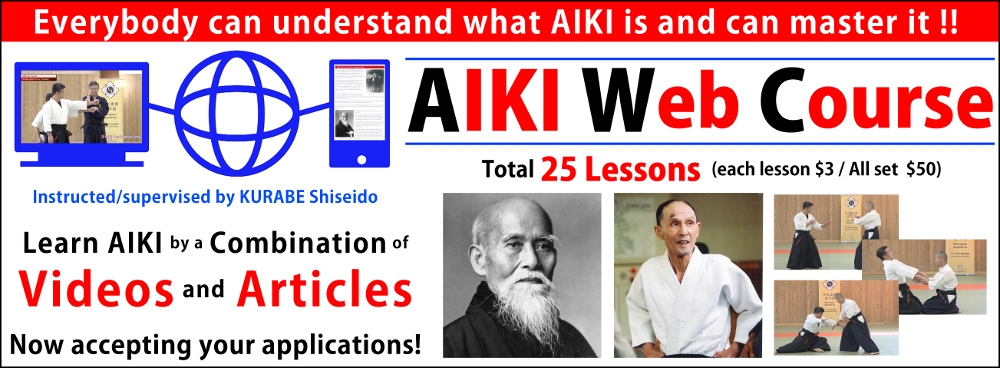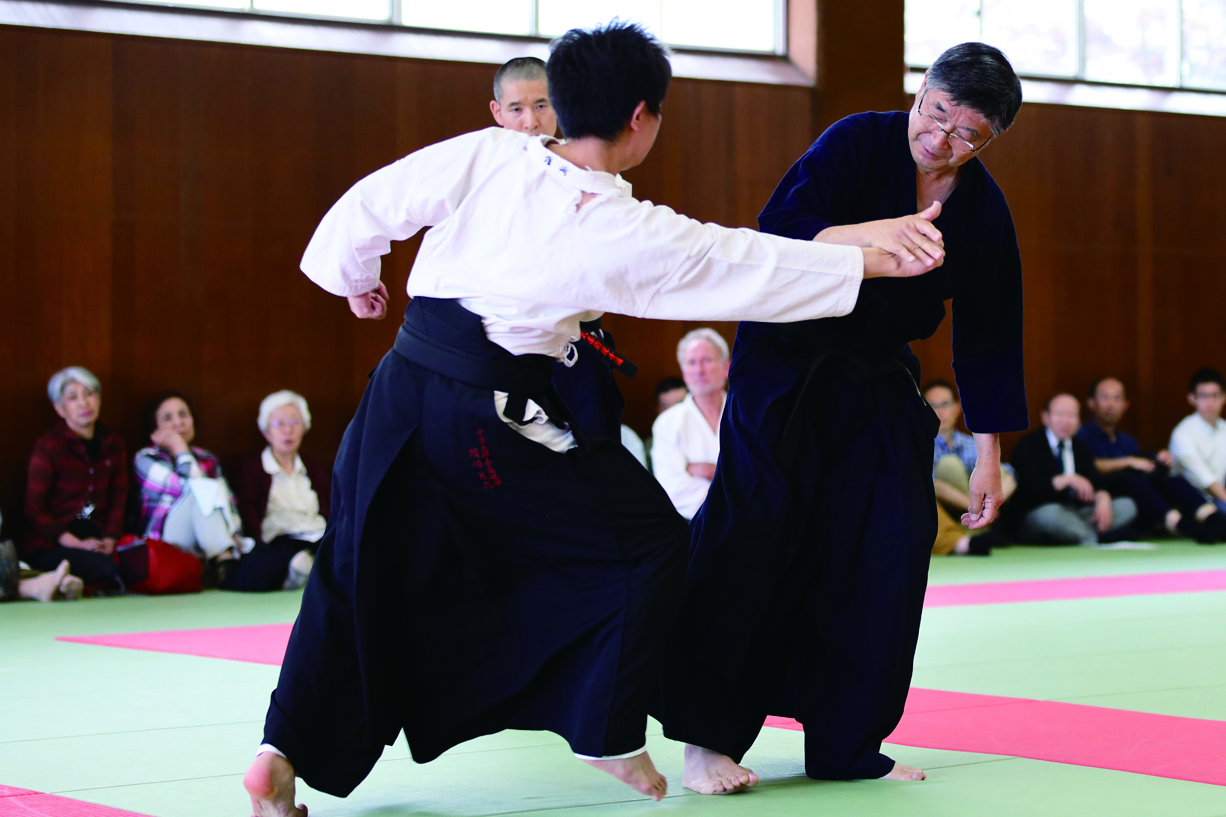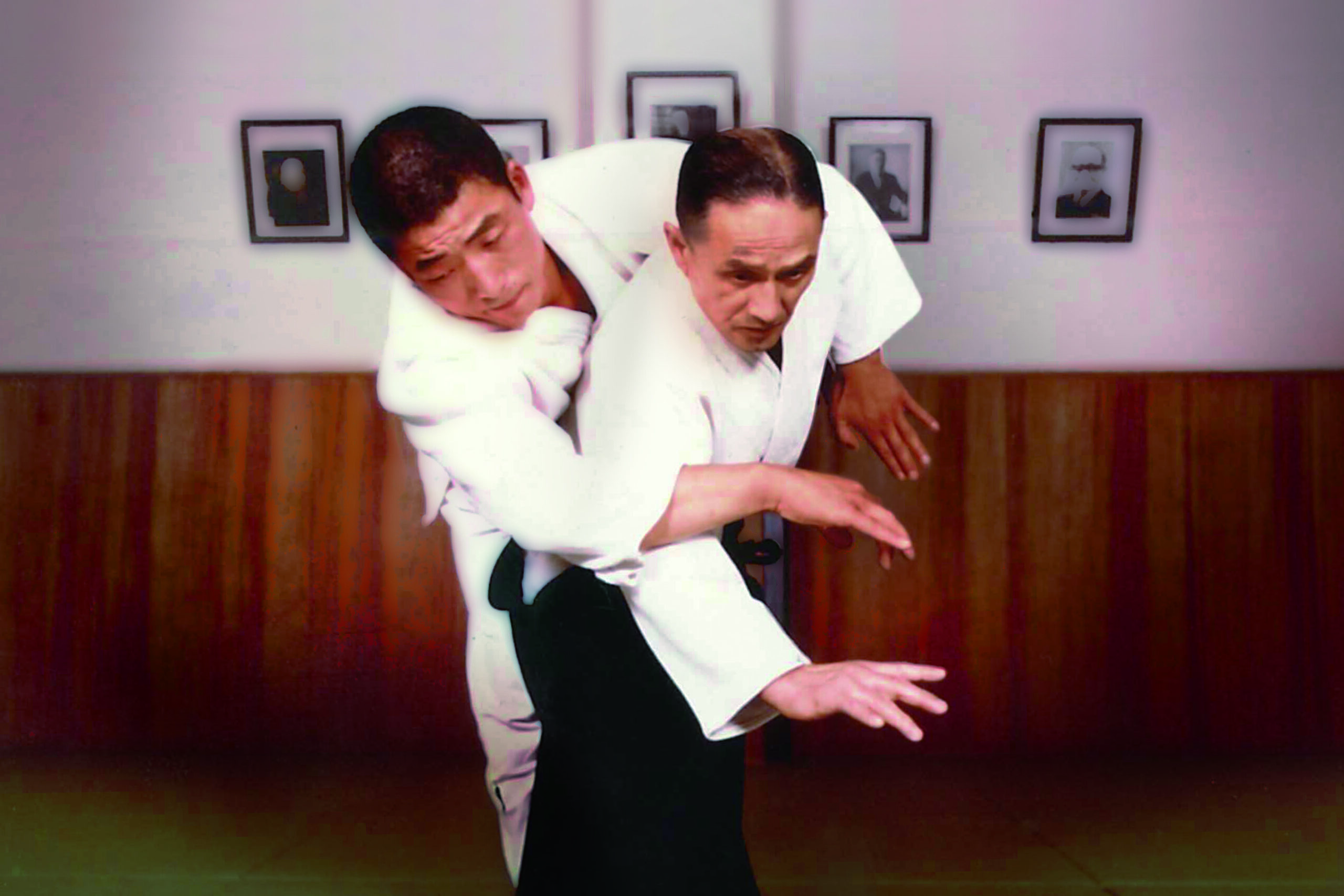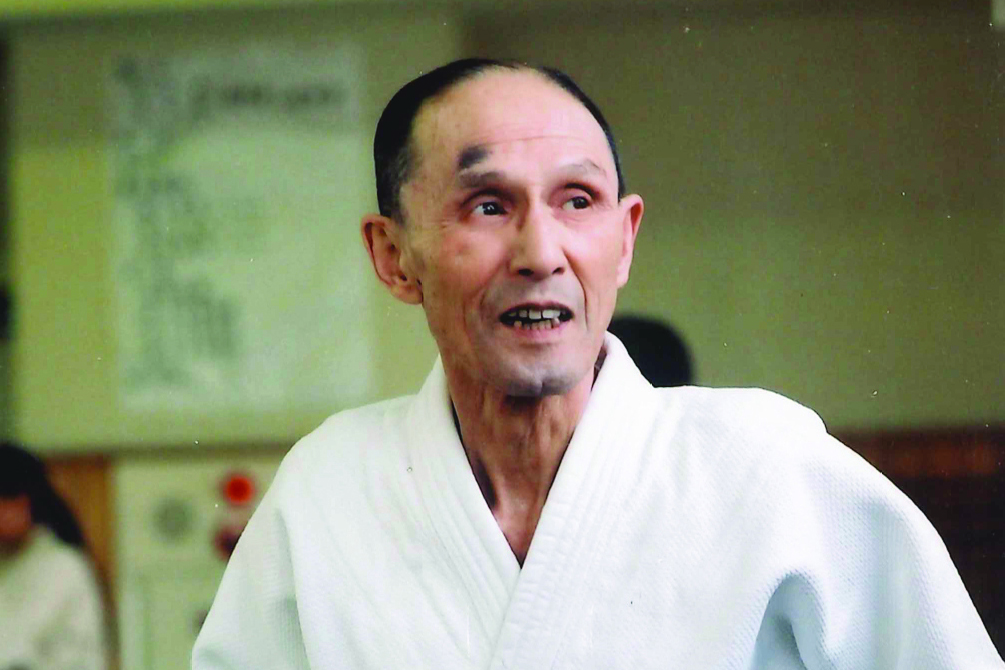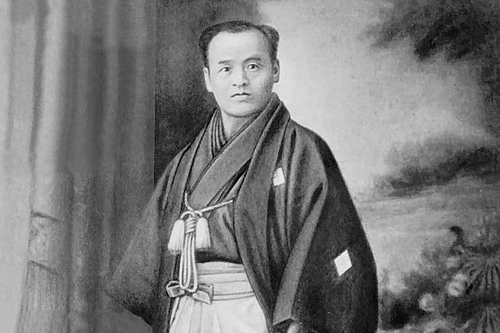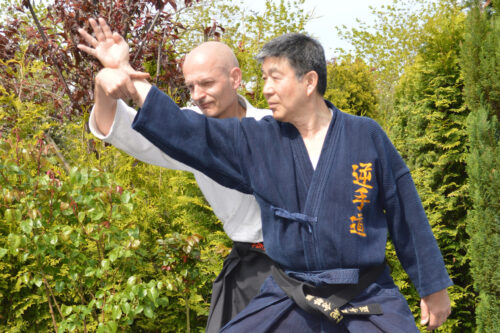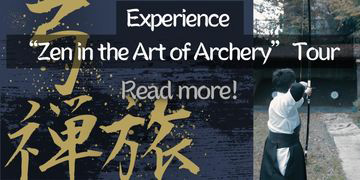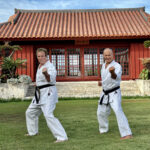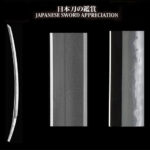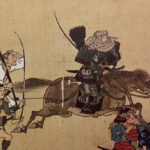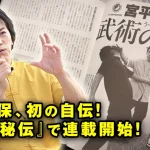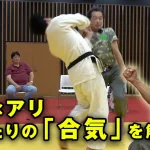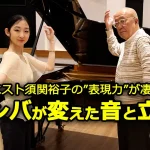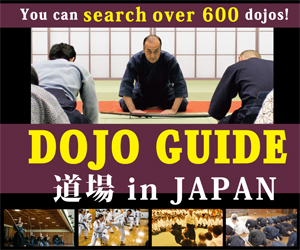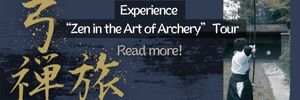» At the starting of AIKI Web Course
【AIKI JUJUTSU GYAKUTE-DO Series No.4】DAKEN-HO Hit and Kick KATA and AIKI
DAKEN-HO KATA
Original DAKEN-HO KATA consists of Part A which varies total 10 and Part B which is common for all 10 KATA.
1st OMOTE and URA
OMOTE Part A: start by JYODAN SHUTO ATE
UKE attacks TORI by JYODAN SHUTO ATE
TORI:
Step 1 JYODAN SHUTO UKE
Step 2 CHUDAN TSUKI double
Step 3 HIZA KERI with holding UKE’s back shoulder
Part B: UKE TORI
Step 1 Attack TORI by JYODAN SHUTO ATE JYODAN SHUTO UKE
Step 2 CHUDAN MAE KERI HARAI UKE
Step 3 CHUDAN JYUN TSUKI CHUDAN SHUTO UKE
Step 4 MAWASHI KERI YOKO JUJI UKE
URA Part A: start by JYODAN SHUTO ATE
UKE attacks TORI by JYODAN SHUTO ATE
TORI:
Step 1 JYODAN SHUTO UKE
Step 2 SOKUTO to UKE’s URA HIZA
Step 3 HIJI UCHI TO FACE by holding UKE’S HEAD
Part B: UKE TORI
Step 1 Attack UKE by JYODAN SHUTO ATE JYODAN SHUTO UKE
Step 2 CHUDAN MAE KERI HARAI UKE
Step 3 CHUDAN JYUN TSUKI CHUDAN SHUTO UKE
Step 4 MAWASHI KERI YOKO JUJI UKE
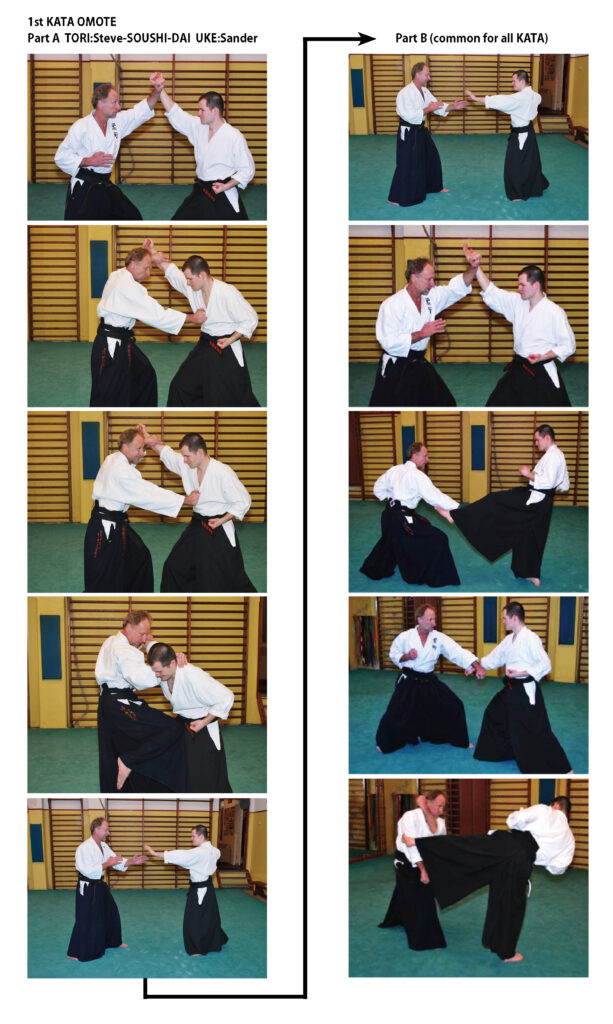
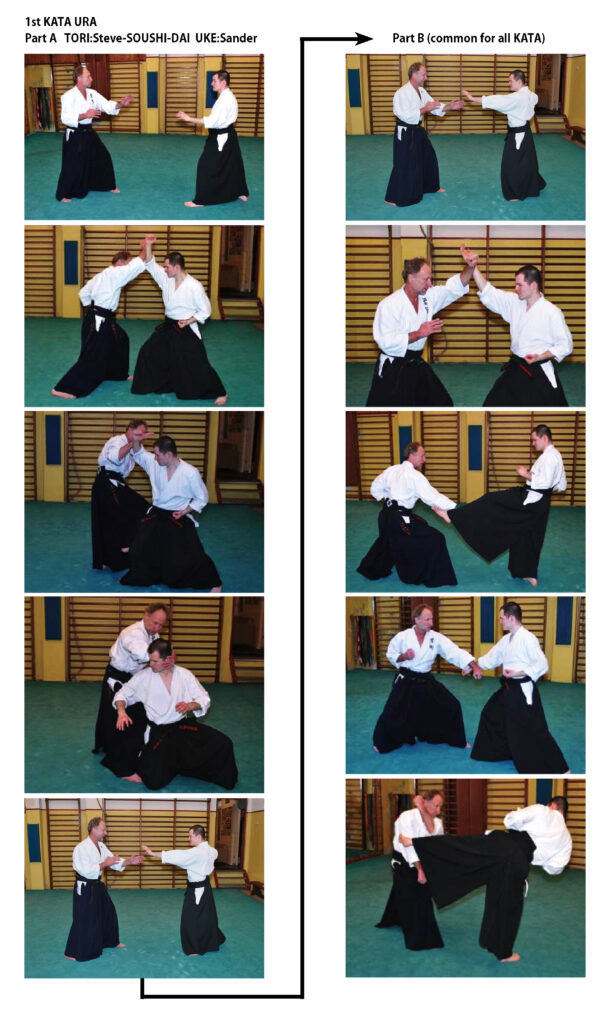
3rd OMOTE and URA
OMOTE Part A: start by CHUDAN JYUN TSUKI
UKE attacks TORI by CHUDAN JYUN TSUKI
TORI:
Step 1 CHUDAN SHUTO UKE and CHUDAN MAE KERI
Step 2 SUIHEI UCHI to UKE’s side head
Step 3 SHOUTE TSUKI
Part B: UKE TORI
Step 1 Attack UKE by JYODAN SHUTO ATE JYODAN SHUTO UKE
Step 2 CHUDAN MAE KERI HARAI UKE
Step 3 CHUDAN JYUN TSUKI CHUDAN SHUTO UKE
Step 4 MAWASHI KERI YOKO JUJI UKE
URA Part A: start by CHUDAN JYUN TSUKI
UKE attacks TORI by CHUDAN JYUN TSUKI
TORI:
Step 1 CHUDAN UKE and URA KEN same time
Step 2 CHUDAN UKE and SHUTO UKE
Step 3 SUZU KERI with holding UKE’s back neck
Step 4 HIJI UCHI to UKE’s back head
Part B: UKE TORI
Step 1 Attack UKE by JYODAN SHUTO ATE JYODAN SHUTO UKE
Step 2 CHUDAN MAE KERI HARAI UKE
Step 3 CHUDAN JYUN TSUKI CHUDAN SHUTO UKE
Step 4 MAWASHI KERI YOKO JUJI UKE
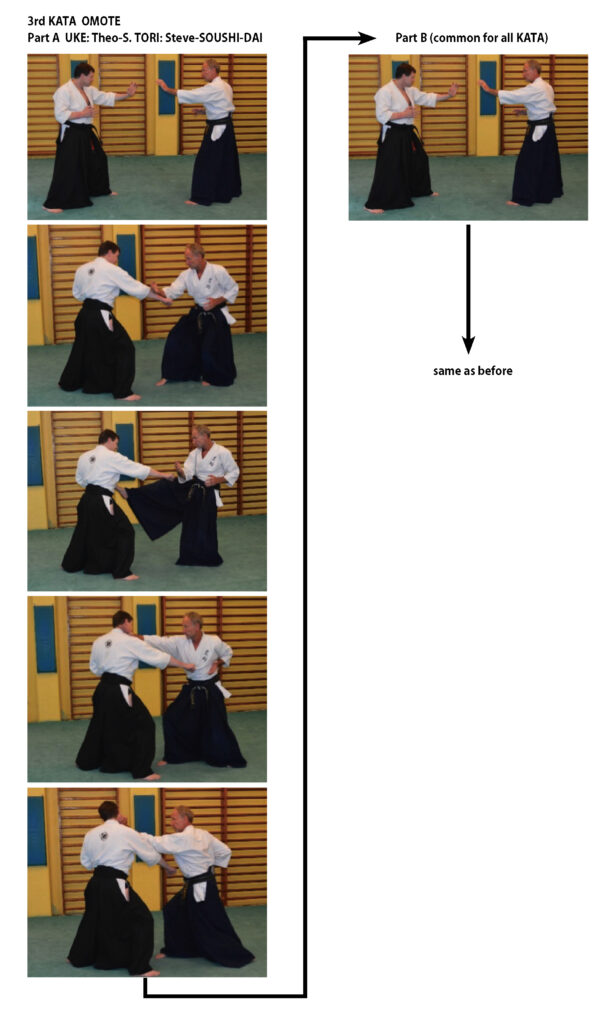
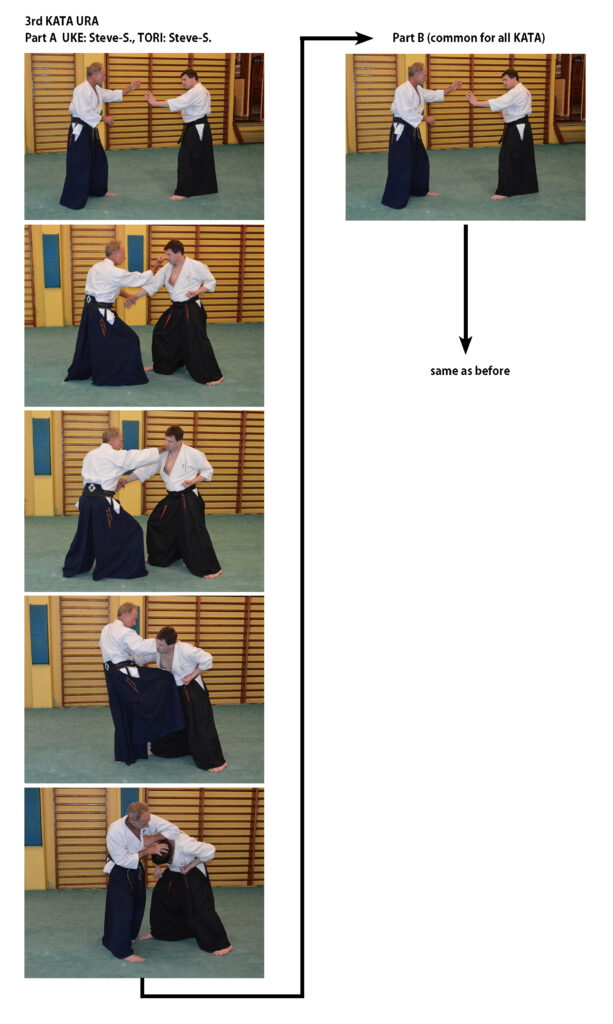
4th OMOTE (and URA)
OMOTE Part A: start by MAE KERI
UKE attacks TORI by MAE KERI
TORI:
Step 1 GEDAN HARAI UKE and JYODAN TSUKI
Step 2 MAE KERI and SHUTO ATE to UKE’s side head by stepping forward
Step 3 SHUTO ATE to UKE’s back head (HACHI WARI)
Part B: UKE TORI
Step 1 Attack UKE by JYODAN SHUTO ATE JYODAN SHUTO UKE
Step 2 CHUDAN MAE KERI HARAI UKE
Step 3 CHUDAN JYUN TSUKI CHUDAN SHUTO UKE
Step 4 MAWASHI KERI YOKO JUJI UKE
5th OMOTE
OMOTE Part A: start by MAWASI KERI
UKE attacks TORI by MAWASHI KERI
TORI:
Step 1 GEDAN HARAI UKE and CHUDAN GYAKU TSUKI
Step 2 SUZU KRI with holding UKE’s both shoulders
Step 3 SHUTO ATE to UKE’s neck root with pushing UKE’s shoulder by hand
Part B: UKE TORI
Step 1 Attack UKE by JYODAN SHUTO ATE JYODAN SHUTO UKE
Step 2 CHUDAN MAE KERI HARAI UKE
Step 3 CHUDAN JYUN TSUKI CHUDAN SHUTO UKE
Step 4 MAWASHI KERI YOKO JUJI UKE
6th OMOTE
OMOTE Part A: start by MAWASI KERI
UKE attacks TORI by MAWASHI KERI
TORI:
Step 1 YOKO JYUJI UKE
Step 2 MAE KERI
Step 3 SHUTO ATE to UKE’s back head (HACHI WARI) with holding UKE’s upper head
Part B: UKE TORI
Step 1 Attack UKE by JYODAN SHUTO ATE JYODAN SHUTO UKE
Step 2 CHUDAN MAE KERI HARAI UKE
Step 3 CHUDAN JYUN TSUKI CHUDAN SHUTO UKE
Step 4 MAWASHI KERI YOKO JUJI UKE
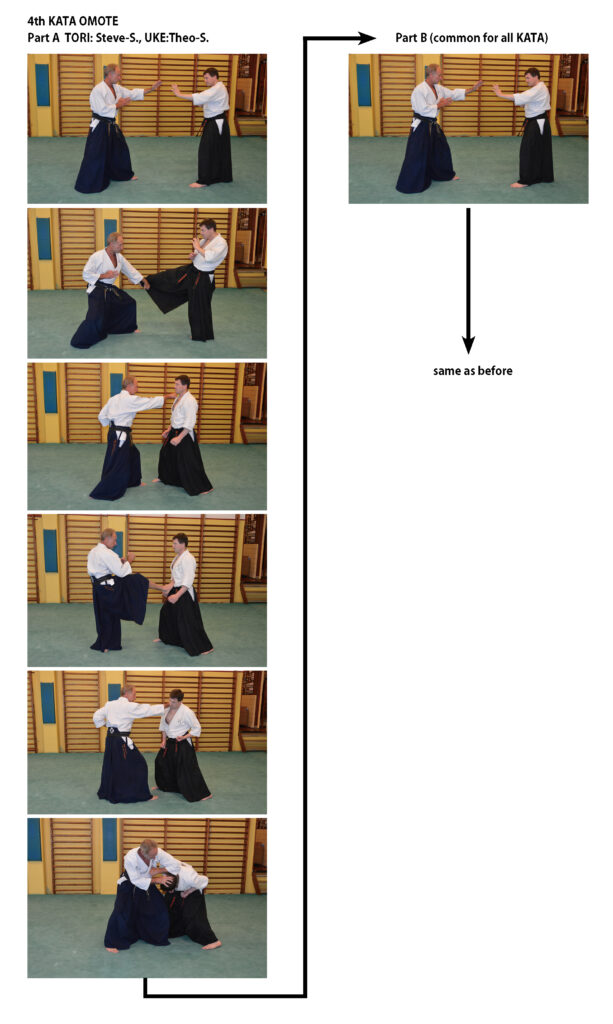
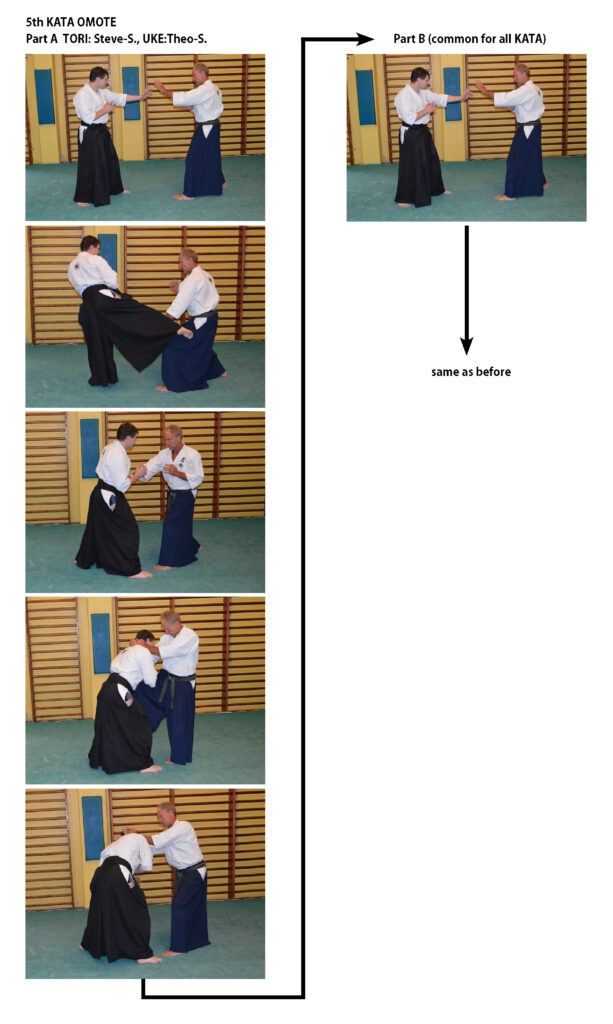

How Aiki Works
The Aiki’s definition, I consider as below.
“The human brain has an OS (operation system) that controls the muscles, and it is updated based on the experience accumulated with age. The phenomenon of AIKI is that one becomes in a situation that he, i.e. his brain cannot control his own muscles in the same way computer goes out of control by being infected with a virus. By applying a specific external stimulation to the opponent, regardless of contact or non-contact, the command system that controls the muscles of the opponent’s brain is disabled, making the opponent unable to resist and is collapsed. AIKI is such a technical system.
According to this definition, all the techniques of AIKI that have been published by various people can be explained. The difference in the method of “providing stimulation from the outside” here is nothing but the “definition” of AIKI that has been explained in various ways in the past.
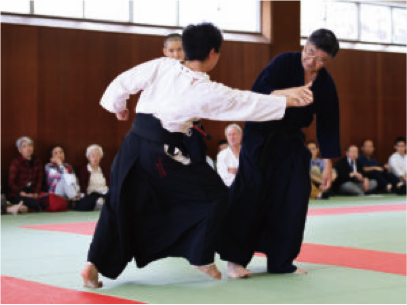
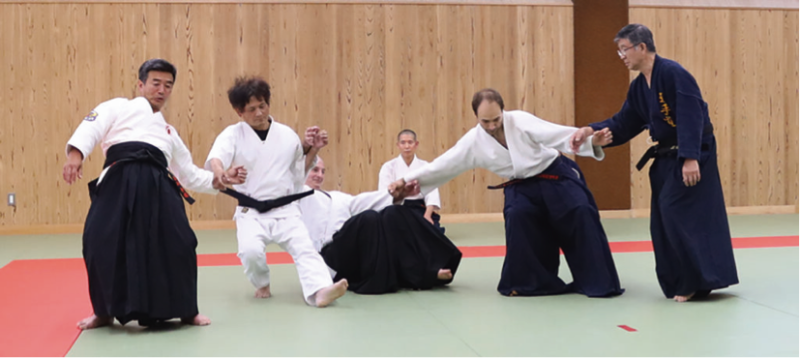
Methods to Realize Aiki
The method of giving stimulation to nullify the muscle control ability of the opponent’s brain is called the “method for realizing AIKI”. These include the following, in order from basic to more advanced (as far as I know, and this is not all).
(1) Waving Method
(2) Non-detectable Force Transfer Method
(3) Targeted Force Transfer Method
(4) AIKI Connection Method
(5) Skin AIKI Method
(6) Force Equilibrium Method
(7) Muscle Current Method
(8) AIKI Mode Method
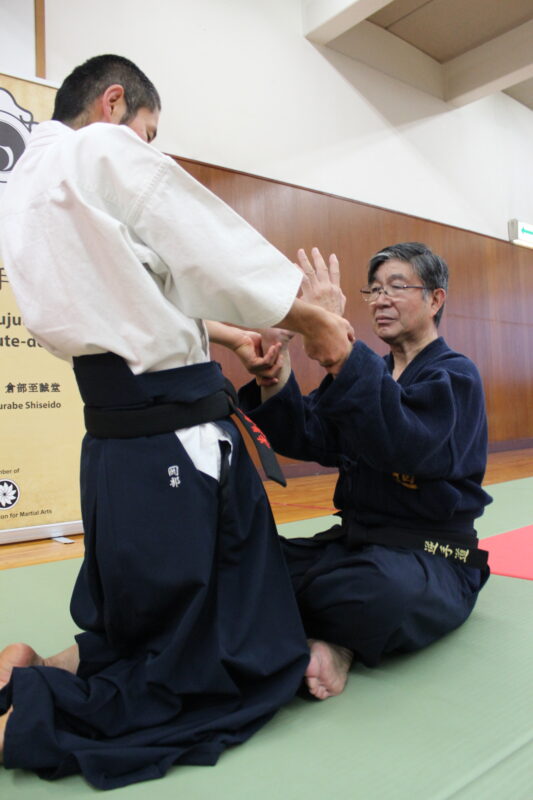
Method is different from Way
I would like to point out one more thing that many AIKI instructors misunderstand the way of realizing the method as “method” and explain it. To give an example, there are many ways to realize the method of the Non-detectable Force Transfer, such as “lifting an arm that has been grabbed as if scratching your itchy ear” or “raising a hand and arm with the intention of swinging up the wooden sword that is being gripped”. It’s just one of the ways but not the method. If you understand the method properly, you can find many ways to realize it, but if you regard one way to realize it as a “method”, there is no further development.
Furthermore, the definition should express the essence of the thing itself. For example, “Defeat the opponent without using force” or “It doesn’t depend on the speed of moving your muscles” is just one of many characteristics of AIKI and is different from the definition of AIKI.
How you can learn Aiki properly
Since I did not study AIKI with a particular teacher, I am free to learn many different methods of AIKI and have no restrictions on teaching them to others. I have heard that some schools forbid the disclosure or teaching of the AIKI that has been learned to outsiders, and in such places, a written oath is required when entering the school. Whether or not you can master AIKI if you learn it in such a place is purely another matter. Being able to do AIKI and being enthusiastic about teaching it to students and others are two completely different things. It is a big mistake to expect that if you become a disciple of a famous AIKI master, you will be able to master AIKI techniques just because they perform excellent AIKI. As you have already understood, unlike other martial arts, AIKI cannot be mastered only by learning its movements. This is one of the main characteristics of AIKI, and one of the reasons why AIKI has not become popular until now.
The detail of Aiki techniques will be described in the other book separately as “Gyakute-do Aiki Book” because it has too huge volume to describe here. You can also watch Aiki techniques at “Web AIKI Course” on Budo Japan website.
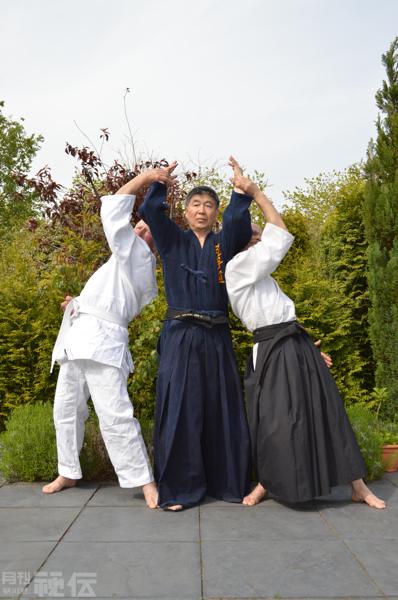
Wrote & supervised by KURABE Makoto SHISEIDO, 2nd Soushi (Grand master) of AIKI Jujutsu Gyakute-do
He was born in 1950 in Kashiwa city Chiba prefecture. Graduated PHD course of Science University of Tokyo. After learning Judo and Shito-ryu Karate-do, started learning Gyakute-do Jujutsu which was created under influence of Hakko-ryu Jujutsu and the other Ko Bujutsu. Since TANAKA Tadashi CHUSHUDO, founder of Gyakute-do, 1st Soushi, passed away and the Ryuha died out without a successor, he had started instructing Gyakute-do seriously to the local Budo fans in the Netherlands so that he can let the name Gyakute-do would not disappear. Besides, during pursuing Gyakute-do, he had discovered the theory of AIKI and had established the methods to realize AIKI and the practicing way in his original way successfully.
Time to time he often writes for the Japanese martial arts journal “Hiden”. So far he has published books “Theory of Vibration Modal Analysis”, “Story of Dutch”, “Fast learning AIKI”, etc., DVDs “How to master AIKI” etc.
Learn AIKI by a Combination of
Videos and Articles!!
» At the starting of AIKI Web Course
with Videos and Free Articles
AIKI Web Course Part 2 24 Lessons
-
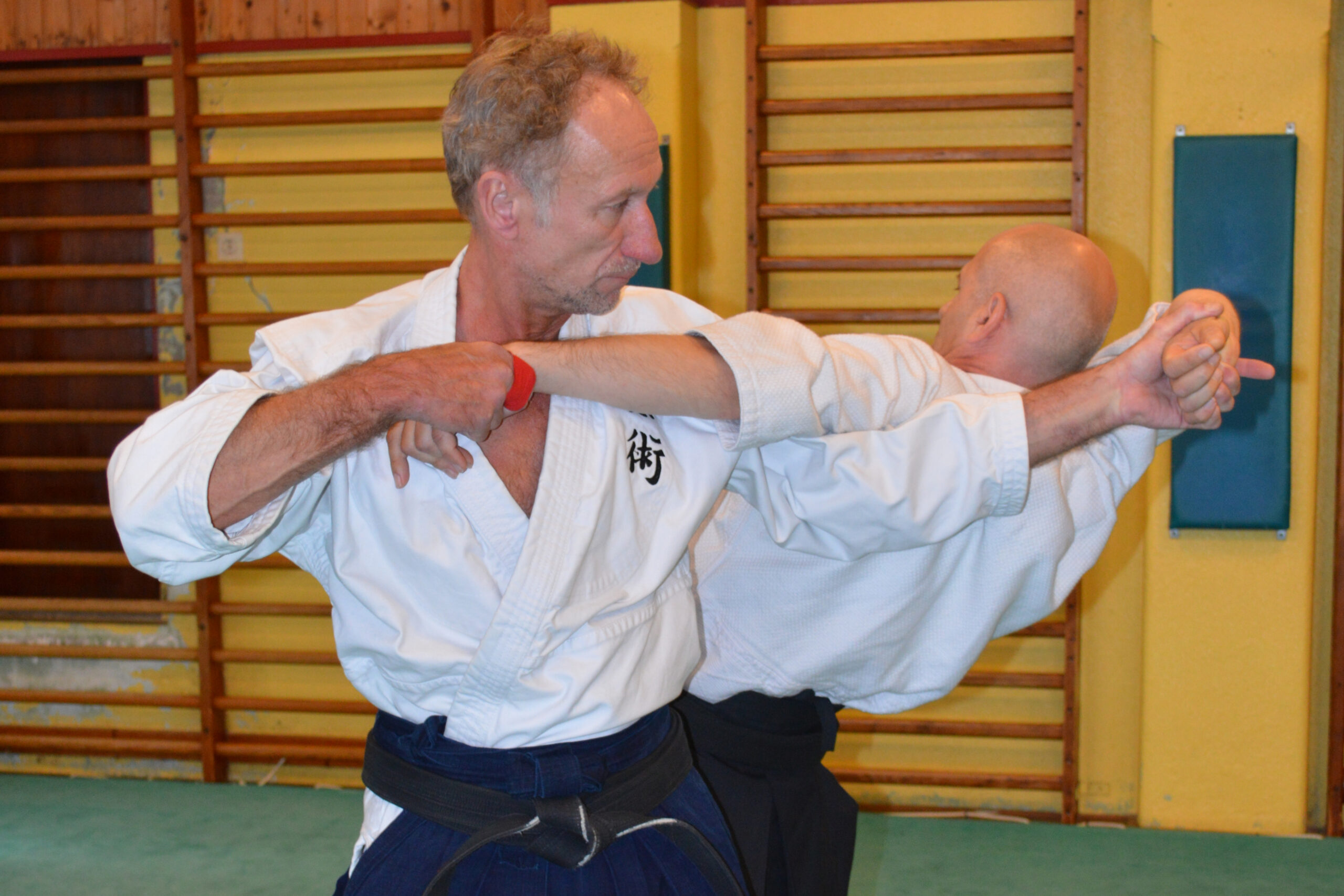
【AIKI JUJUTSU GYAKUTE-DO Series No.5】How you can learn Jujutsu properly
-
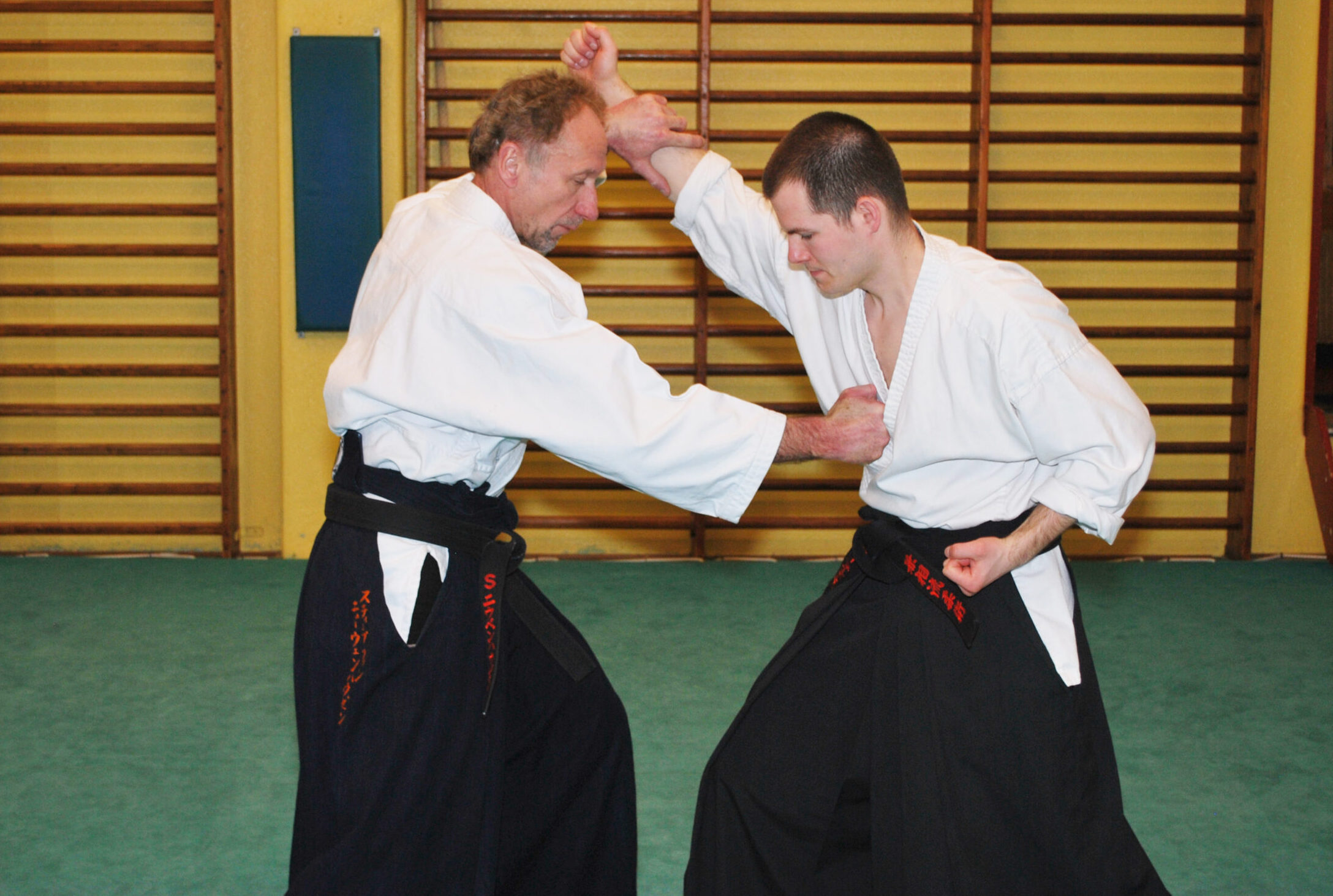
【AIKI JUJUTSU GYAKUTE-DO Series No.4】DAKEN-HO Hit and Kick KATA and AIKI
-
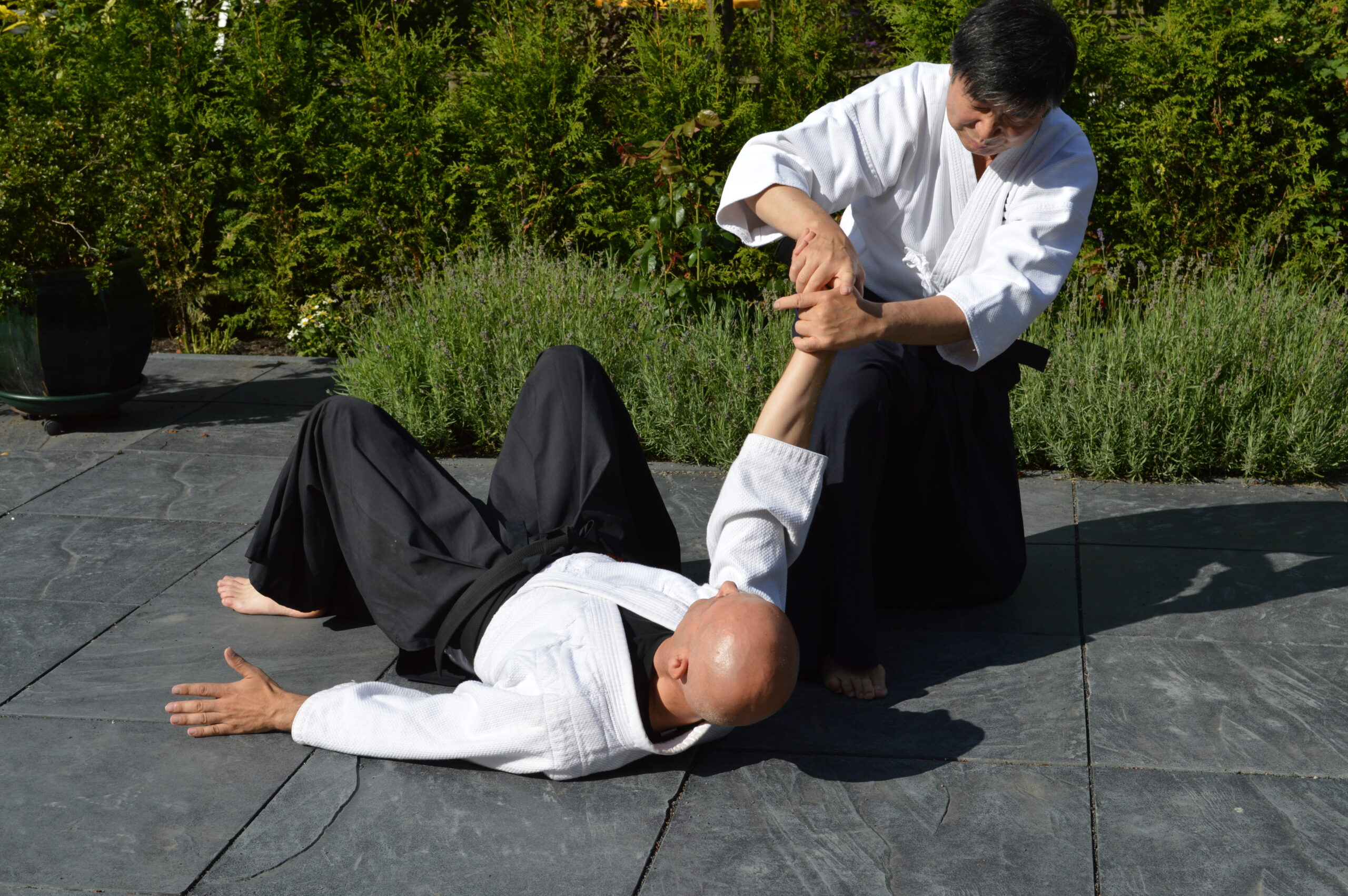
【AIKI JUJUTSU GYAKUTE-DO Series No.3】JUJUTSU WAZA, digest of FUDO
-
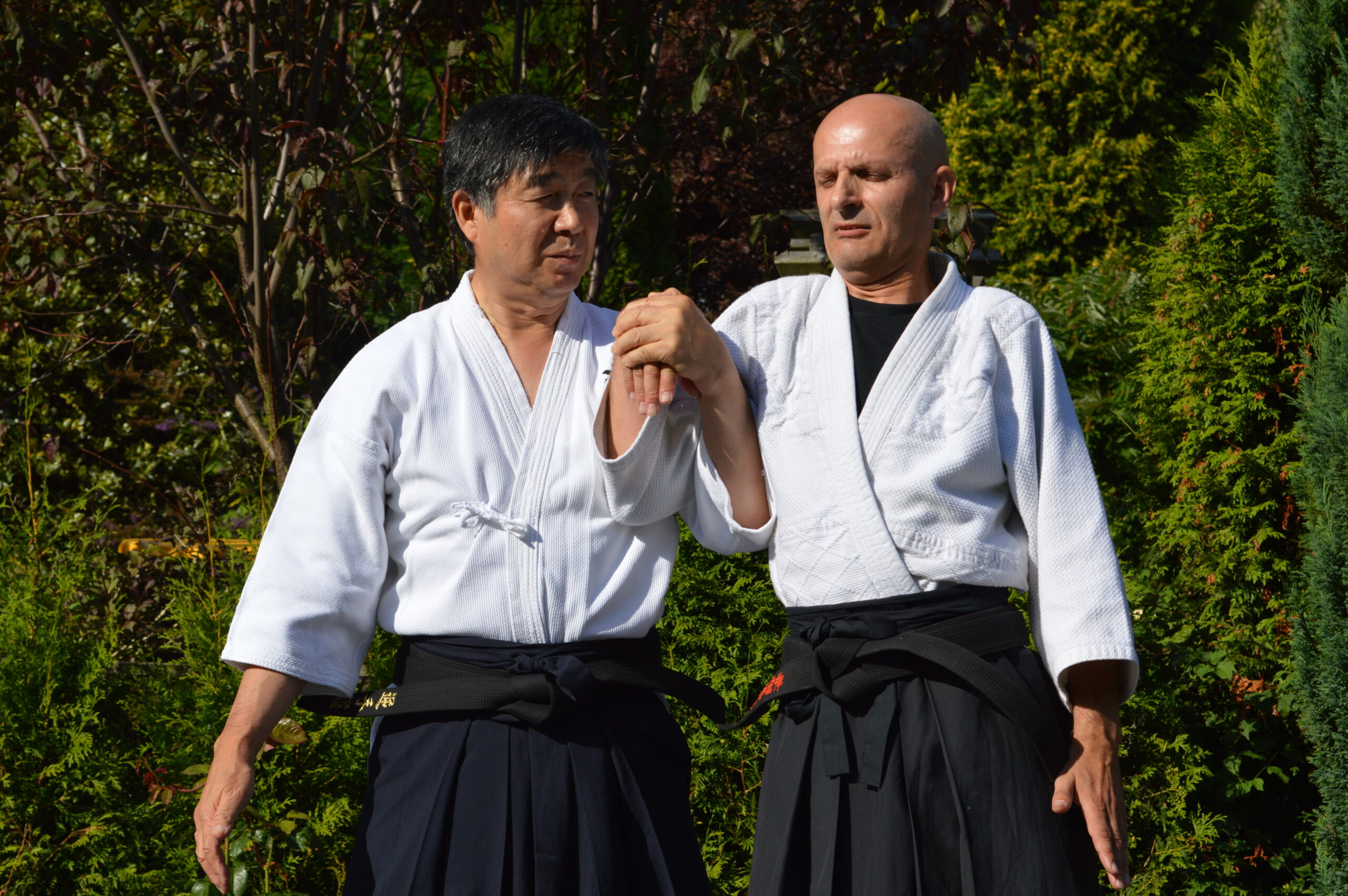
【AIKI JUJUTSU GYAKUTE-DO Series No.2】JUJUTSU WAZA, digest of NUKI, RENKO and NAGE
-
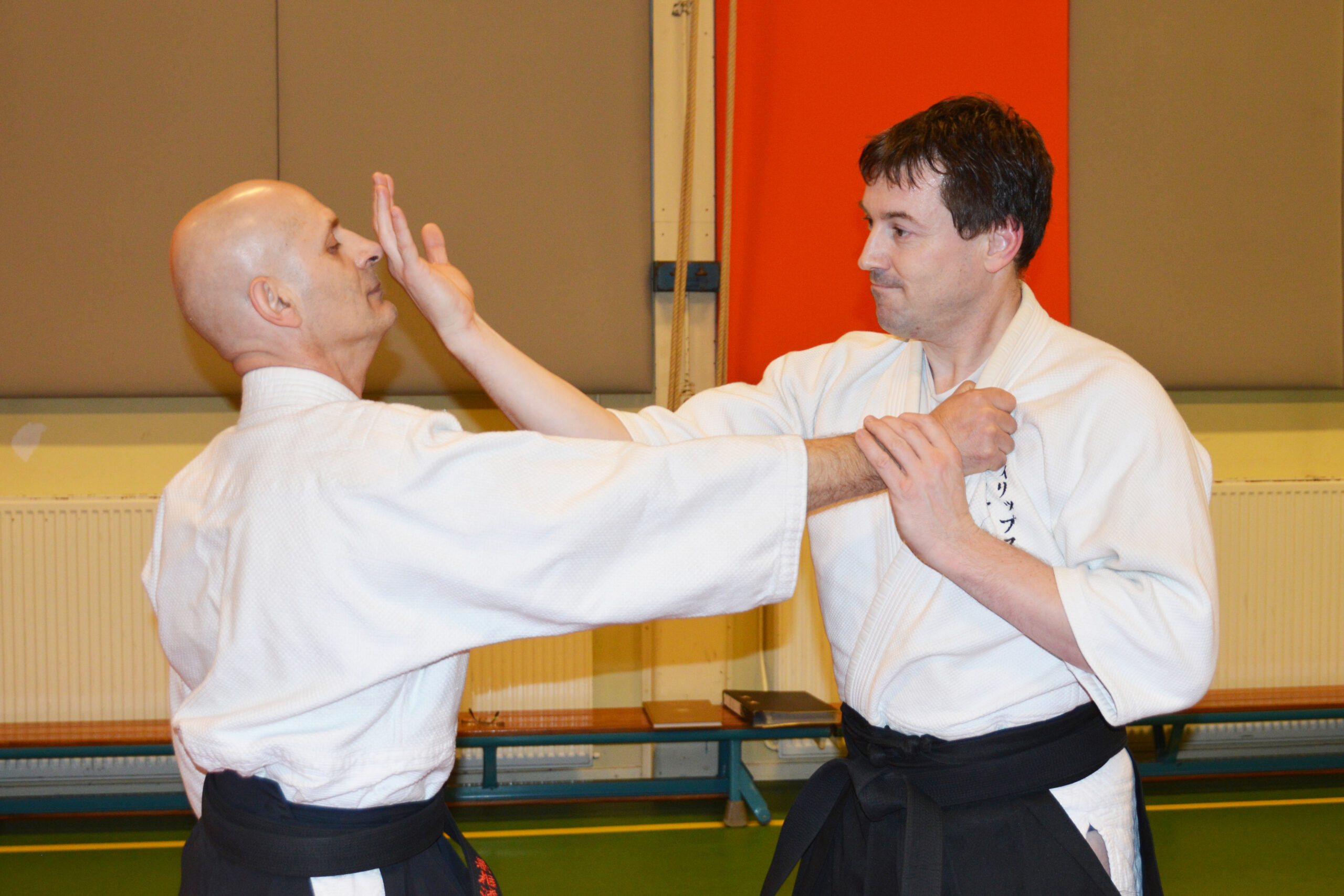
【AIKI JUJUTSU GYAKUTE-DO Series No.1】About GYAKUTE-DO and the digest of its basic techniques
-
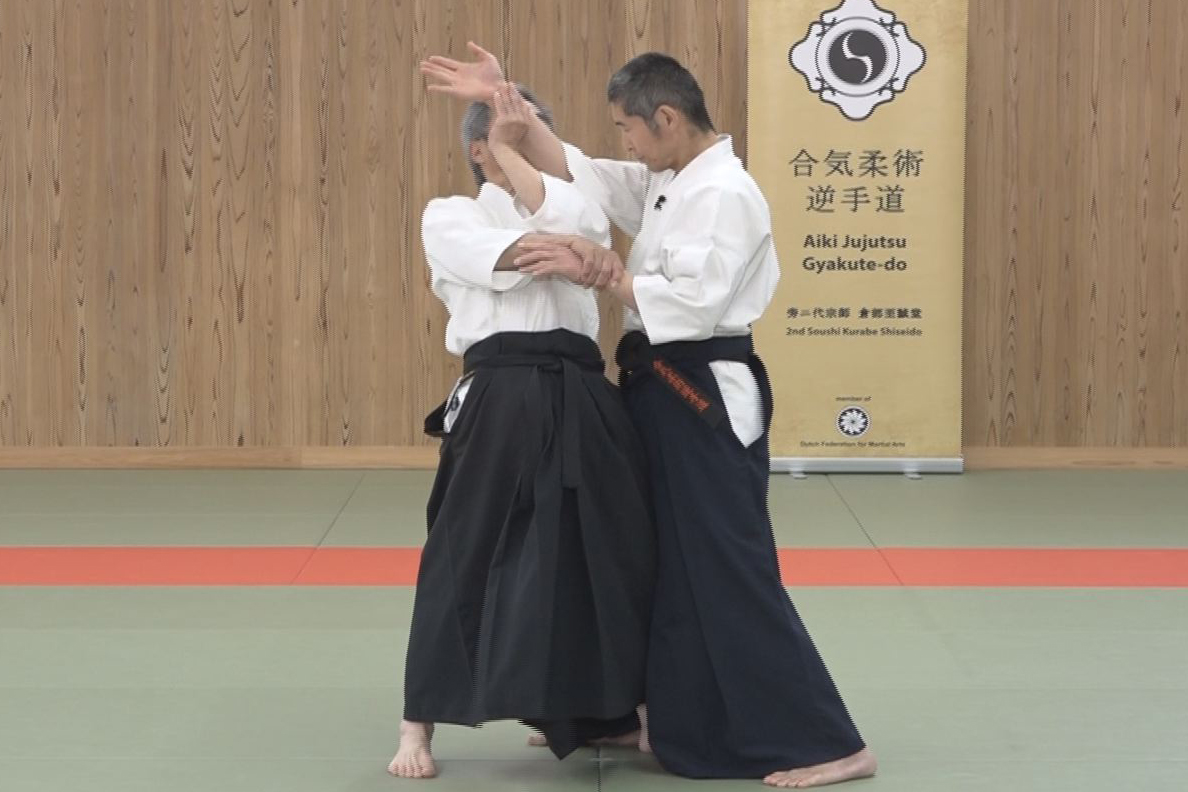
Lesson 24 With Comb. of Different Methods #2
-
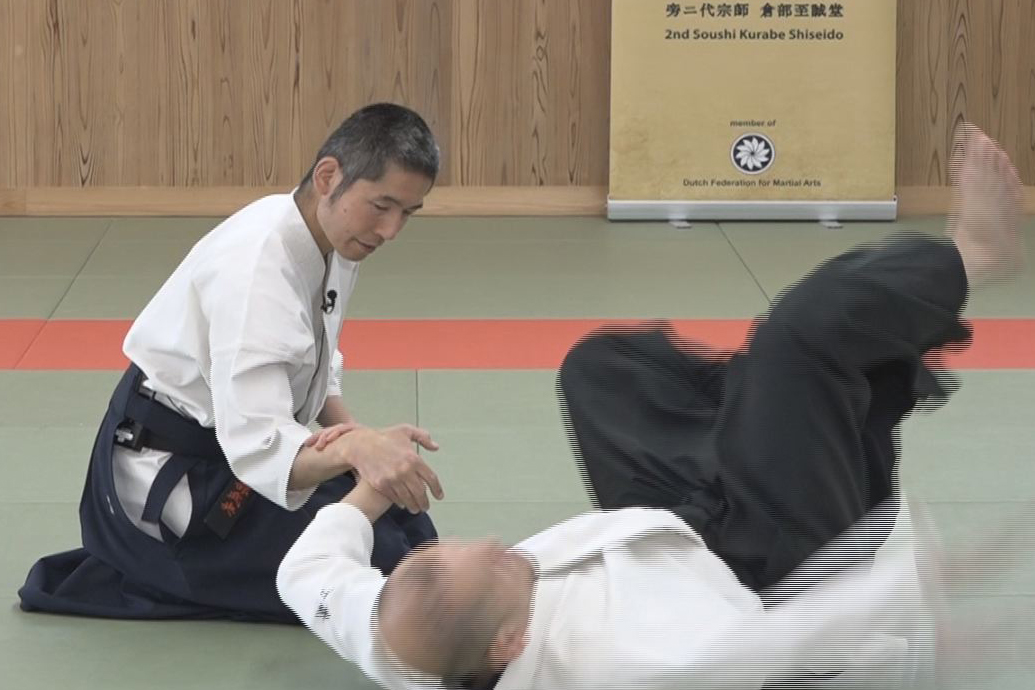
Lesson 23 With Comb. of Different Methods #1
-

Lesson 22 Advanced Tech. using F. E. method #2
-

Lesson 21 Advanced Tech. using F. E. method #1
-
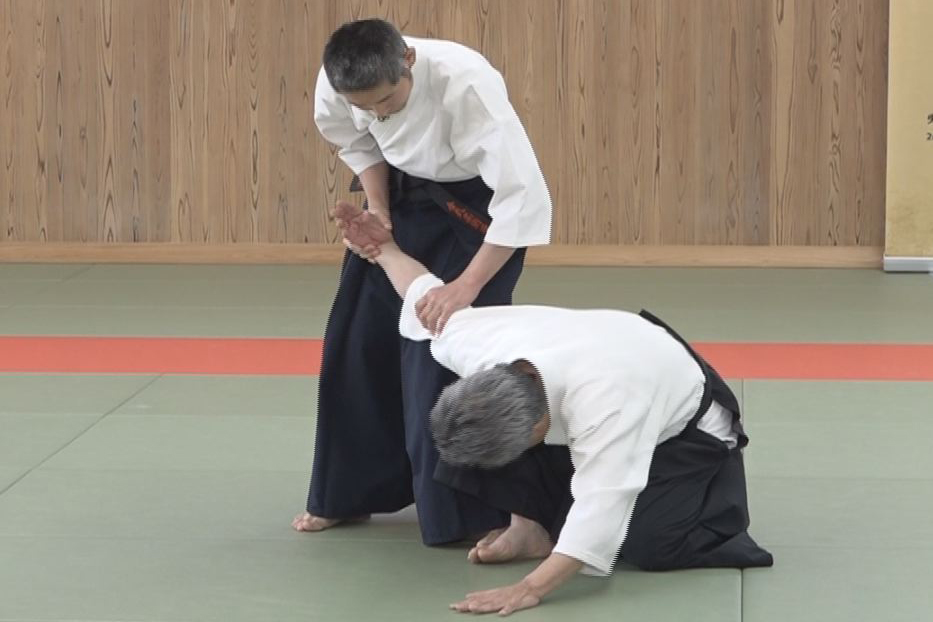
Lesson 20 Advanced tech. using T. F. T. #2
-
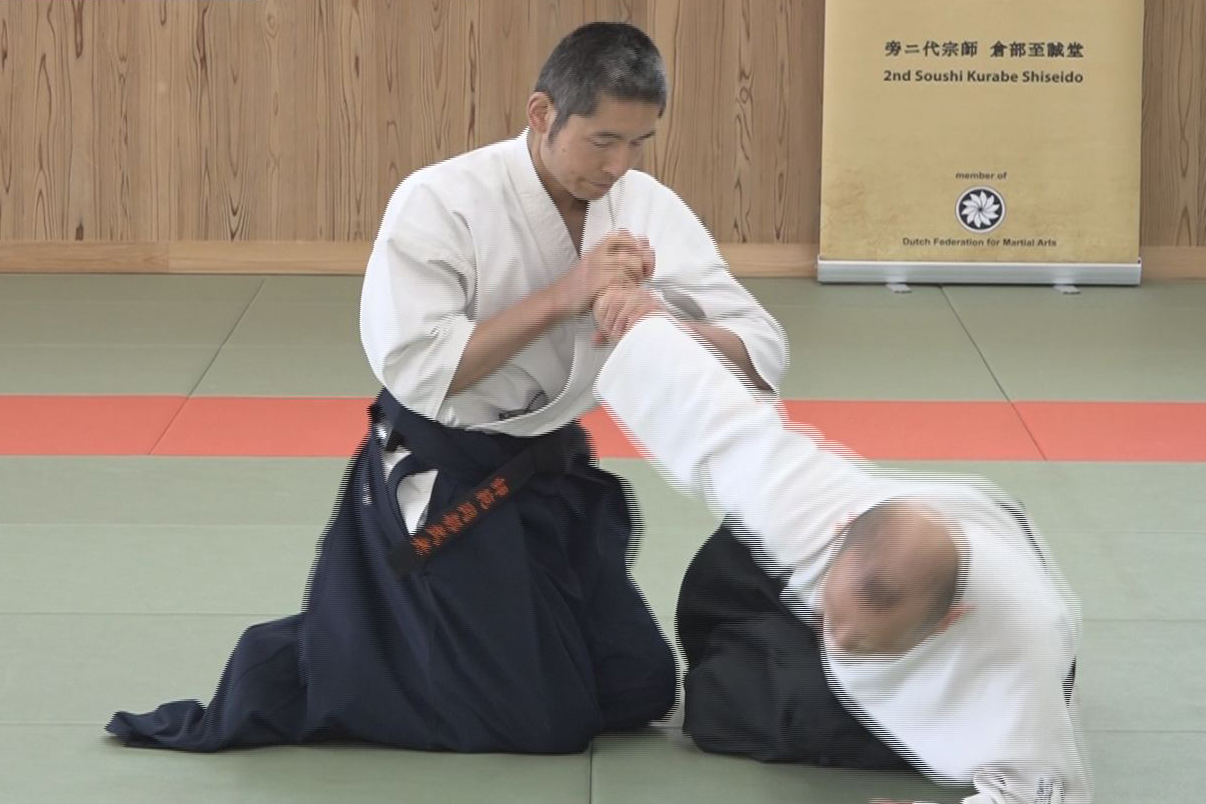
Lesson 19 Advanced tech. using T. F. T. #1
-
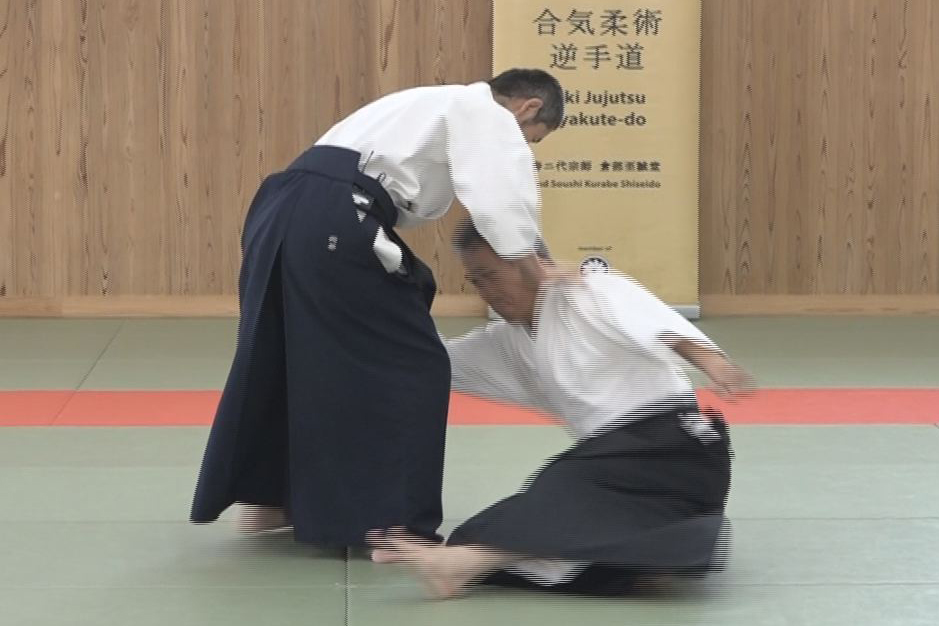
Lesson 18 Advanced tech. using AIKI Contact #2
-
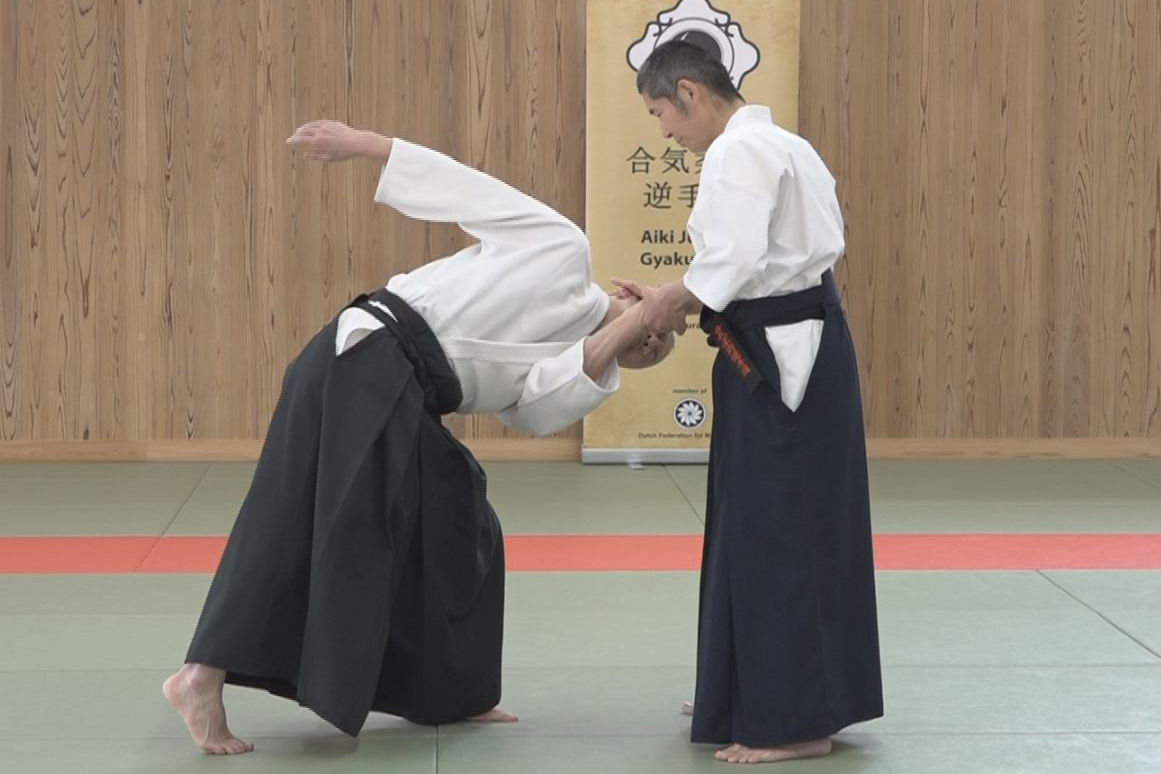
Lesson 17 Advanced tech. using AIKI Contact #1
-
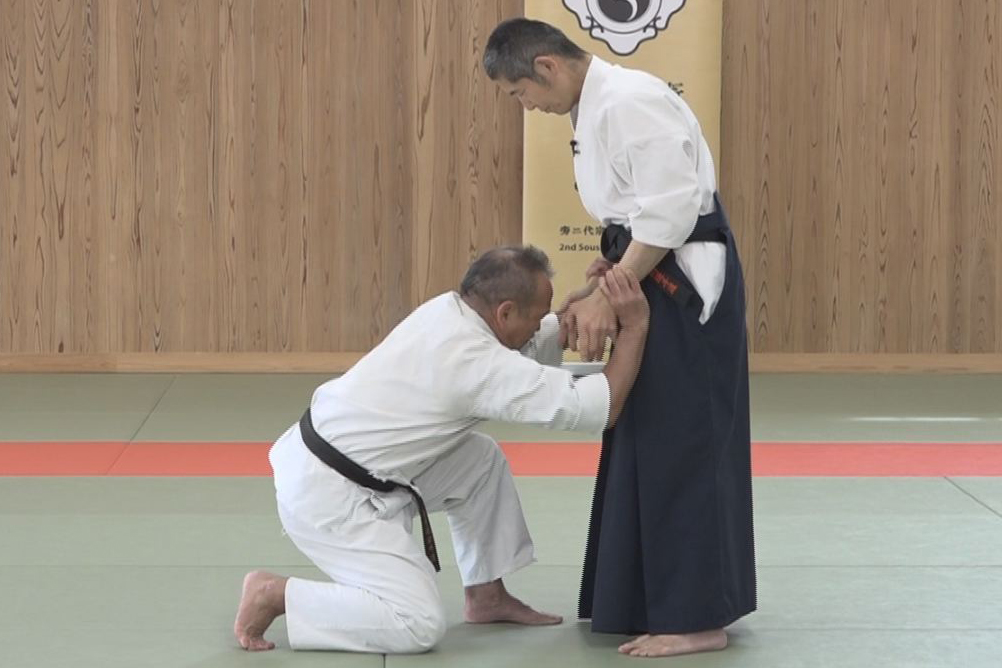
Lesson 16 Advanced tech. by Undetectable F.T. #2
-
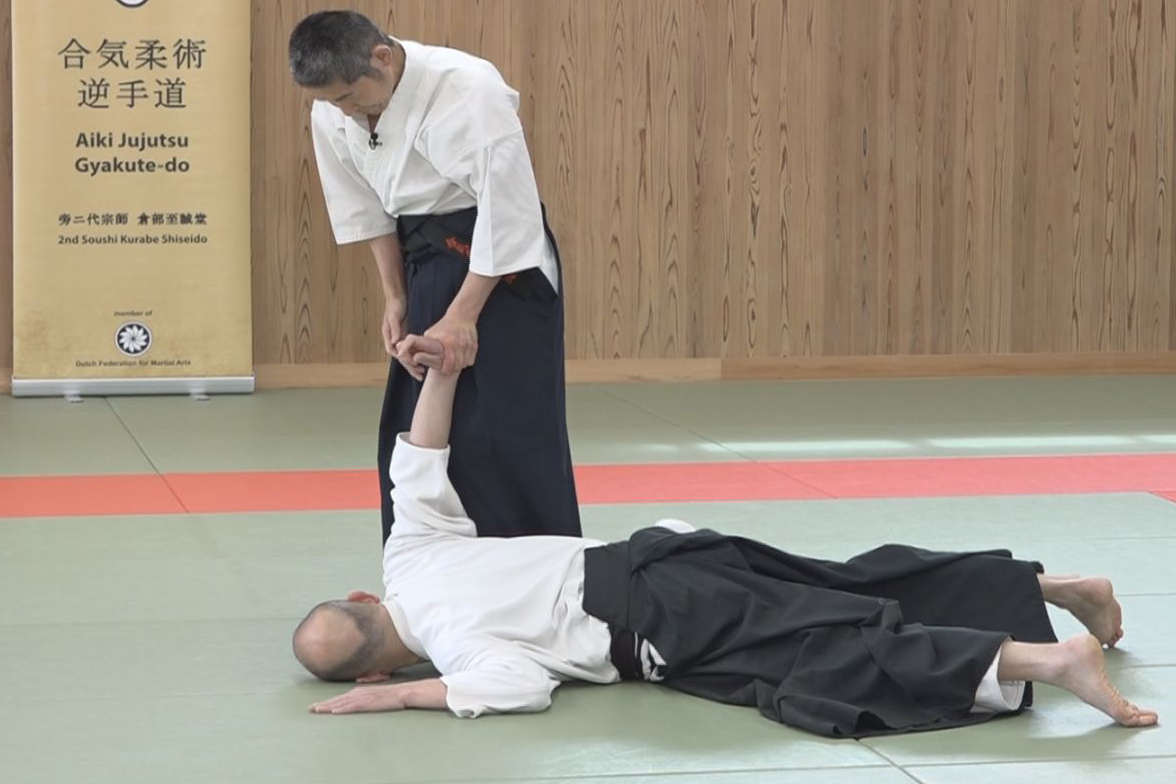
Lesson 15 - Advanced tech. by Undetectable F. T. #1
-
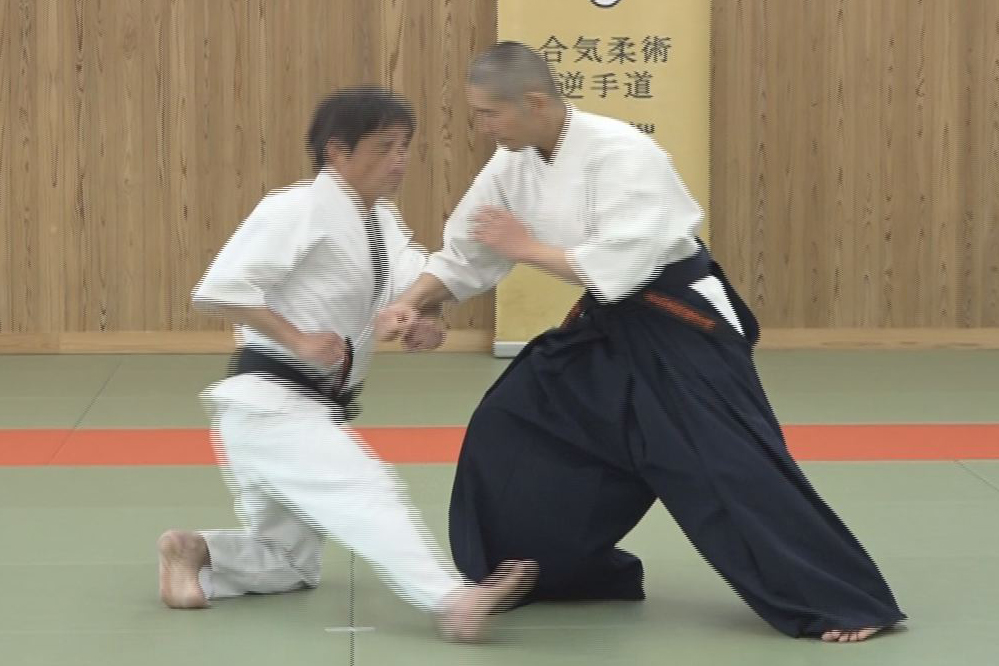
Lesson 14 - Advanced tech. by the Waving method #2
-
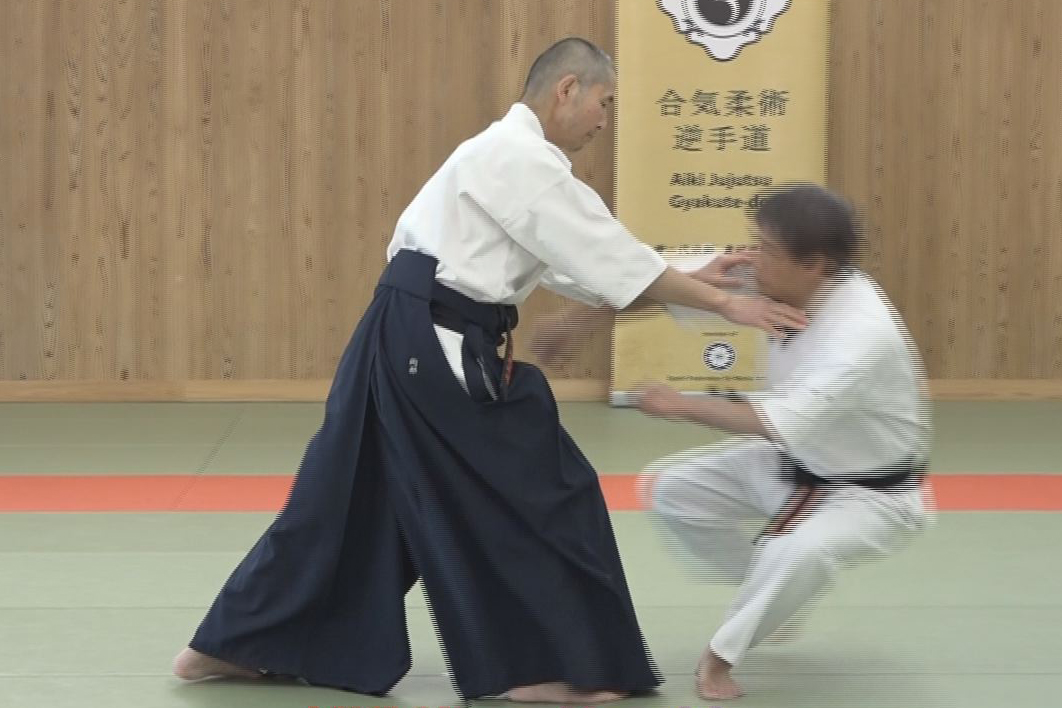
Lesson 13 - Advanced tech. by the Waving method #1
-
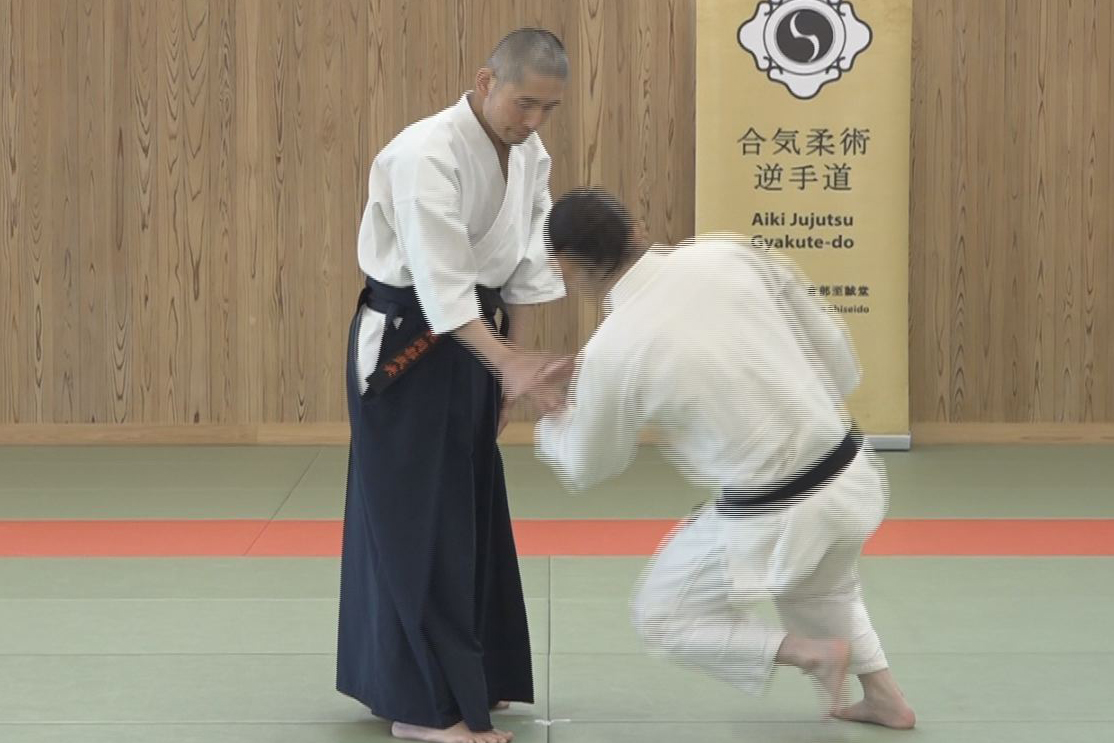
Lesson 12 - Gyaku-te by not Using Force nor AIKI
-
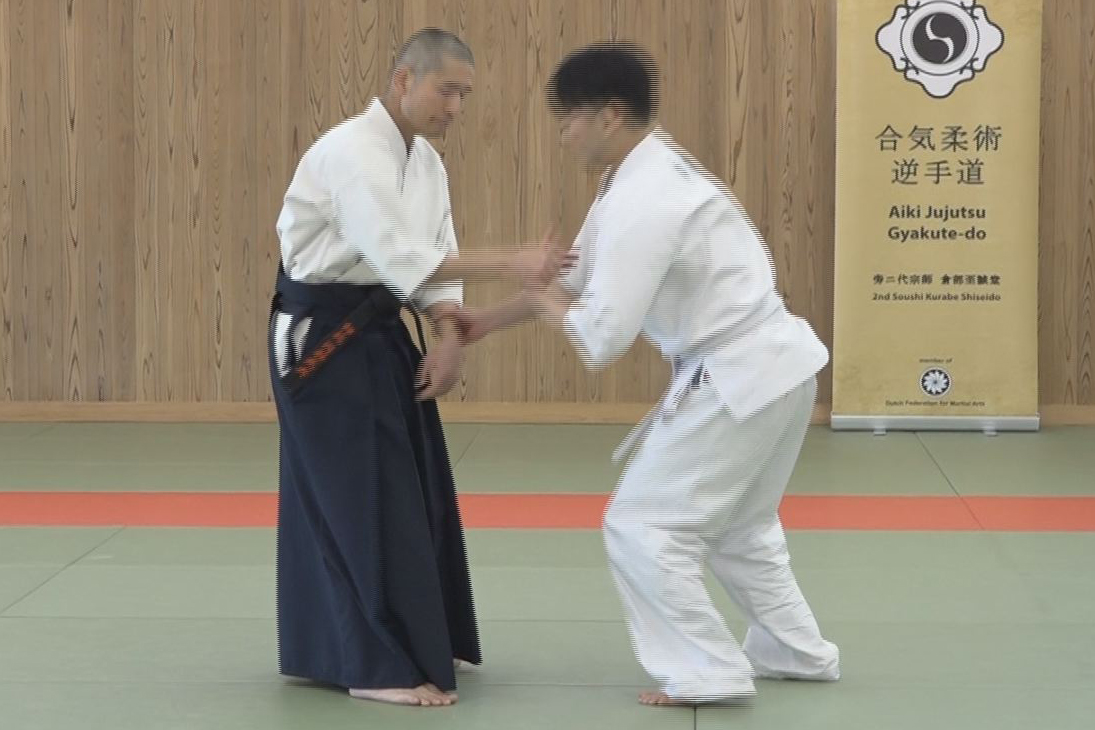
Lesson 11 - Gyaku-te Realized by the AIKI Method
-
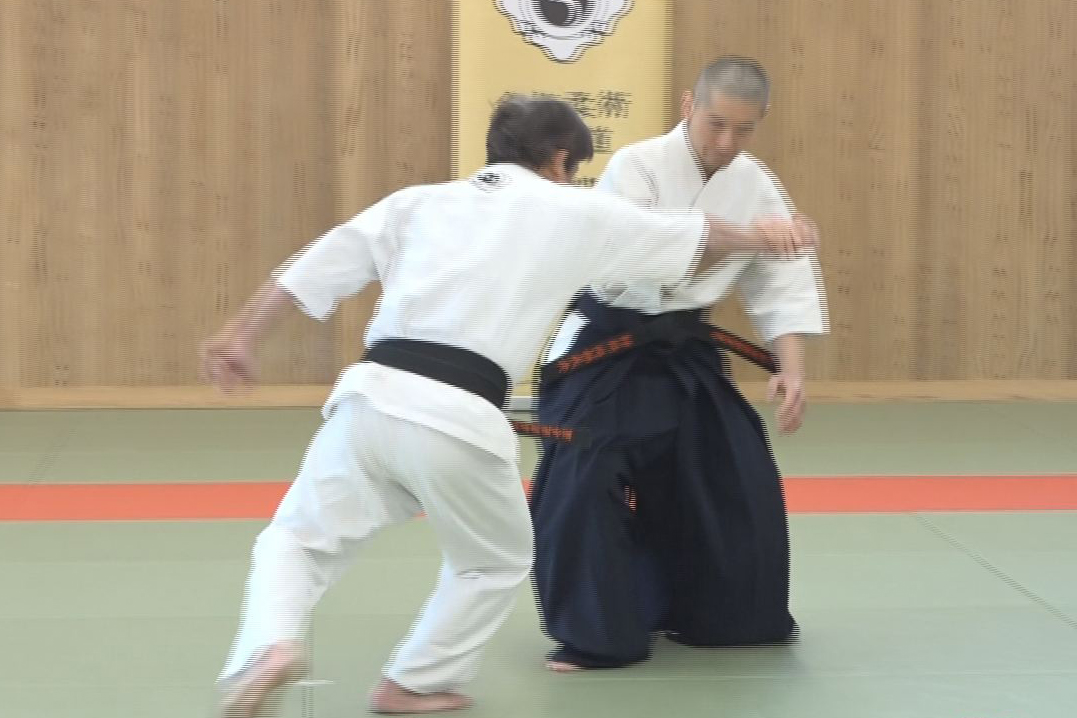
Lesson 10 - Application of Force Equilibrium method
-
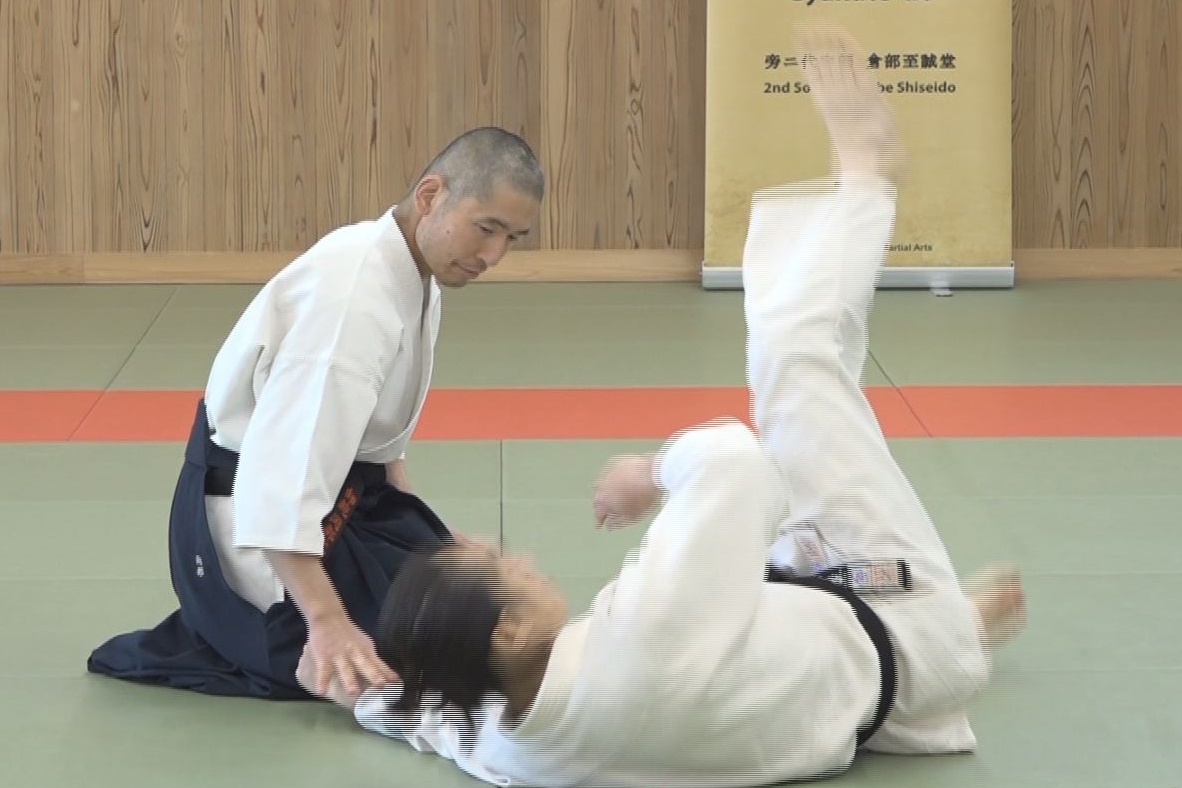
Lesson 9 - Force Equilibrium
-
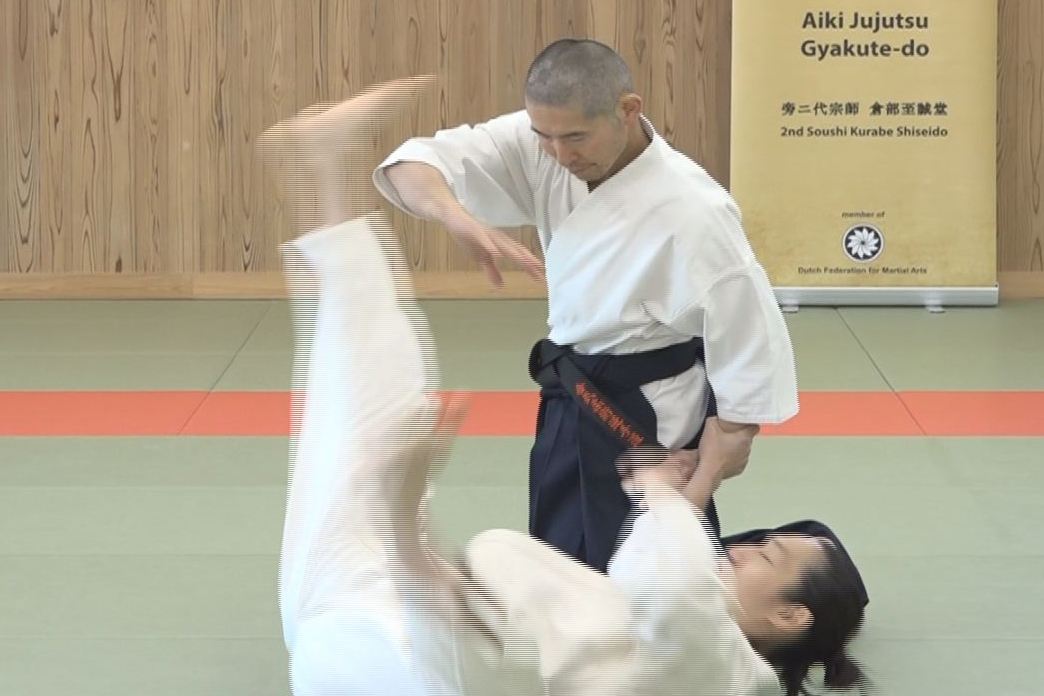
Lesson 8 - Application of Targeted Force Transfer
-
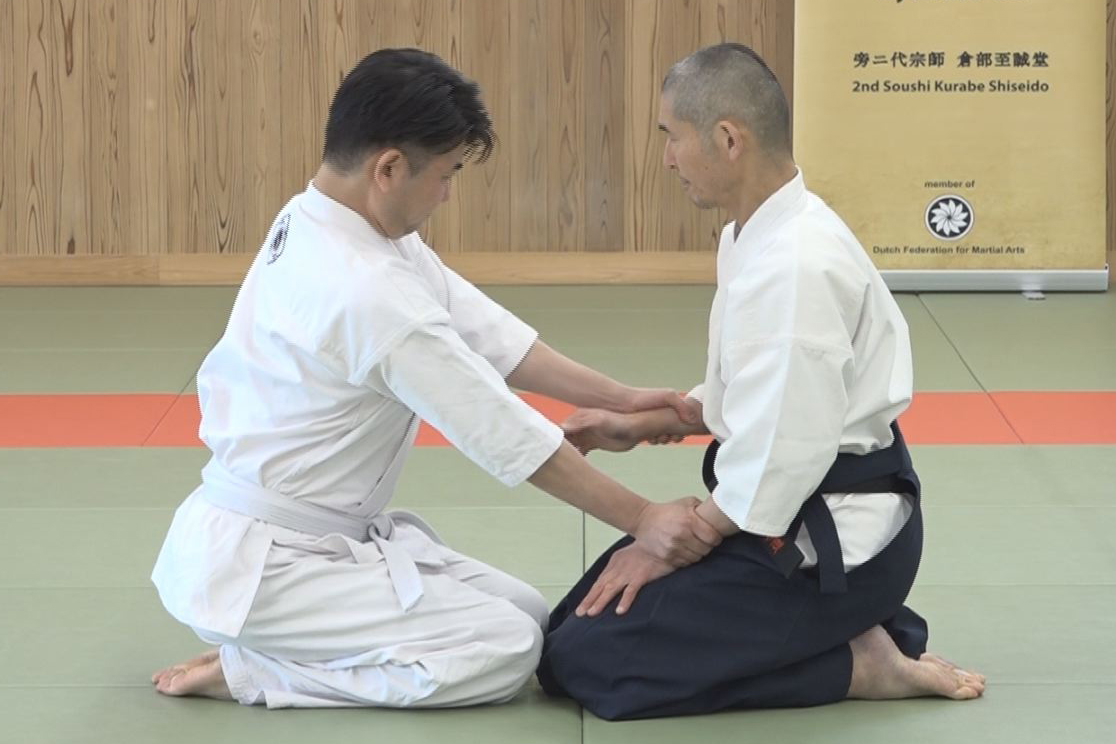
Lesson 7 - Targeted Force Transfer
-
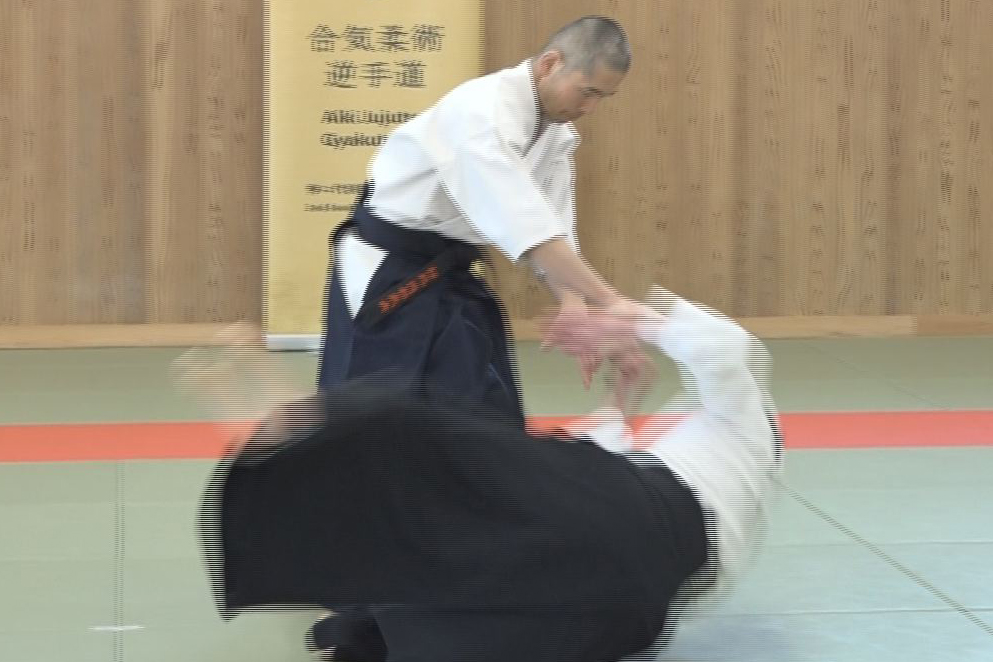
Lesson 6 - Application of AIKI Connection
-
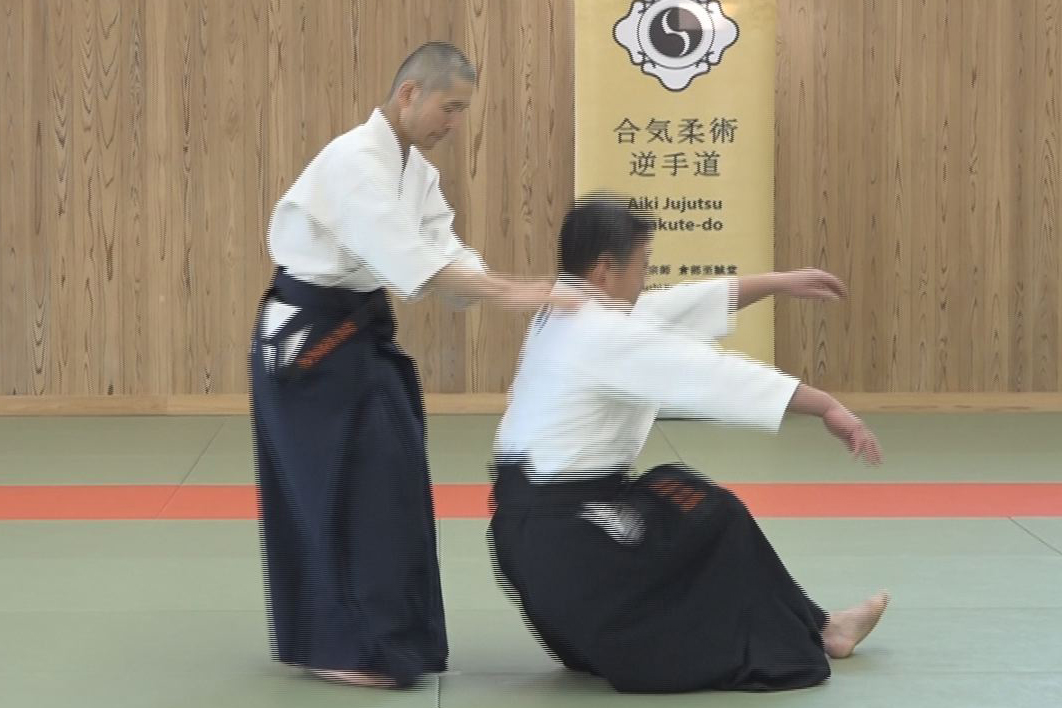
Lesson 5 - AIKI Connection
-
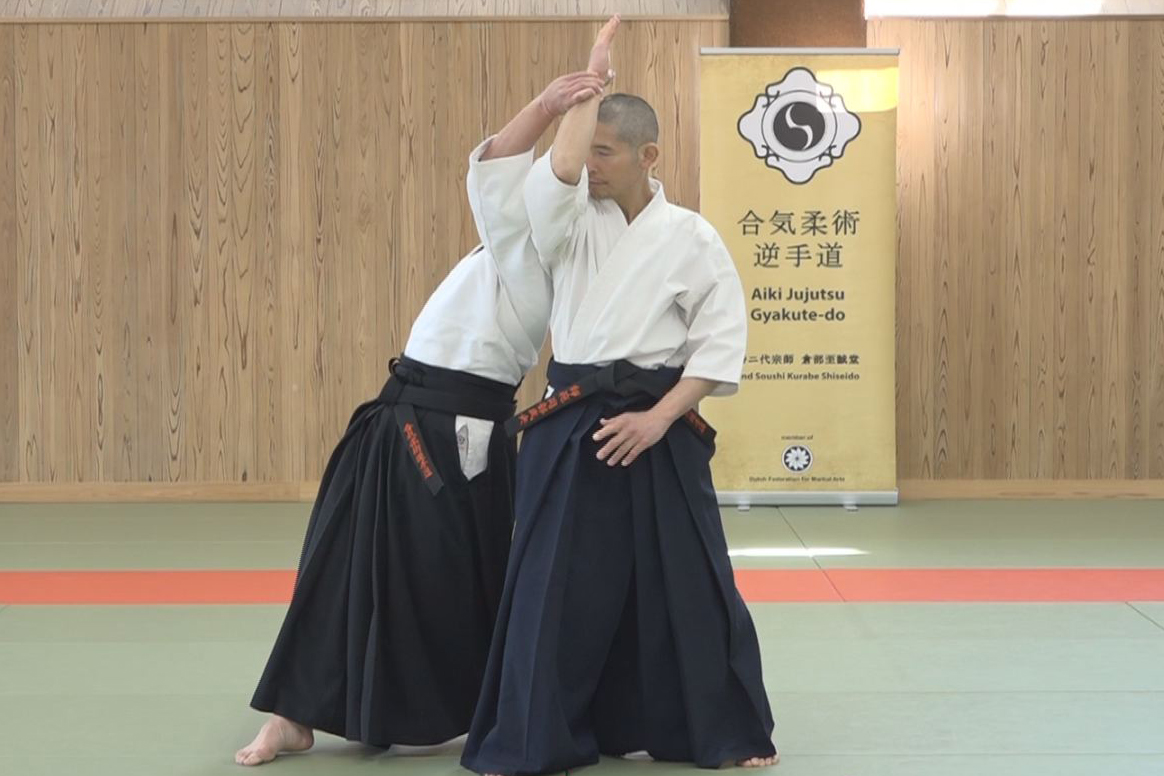
Lesson 4 - Application of Nondetectable Force Transfer
-
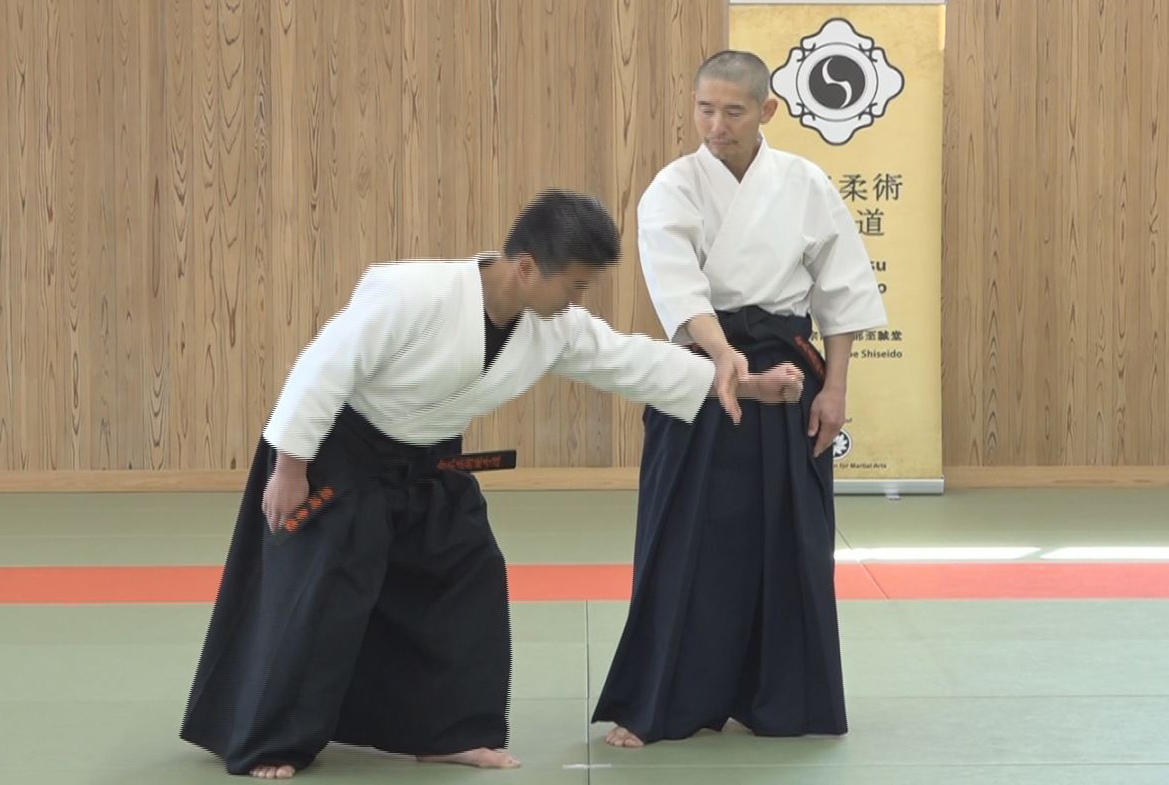
Lesson 3 - Explanation of Undetectable Force Transfer
-
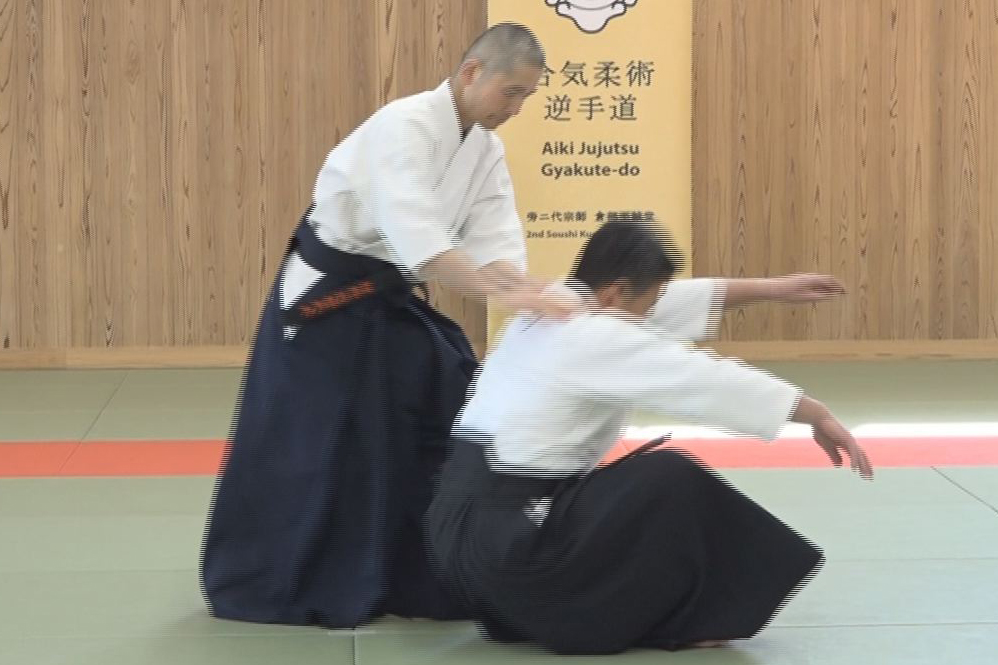
Lesson 2 - Application of Waving Method
-
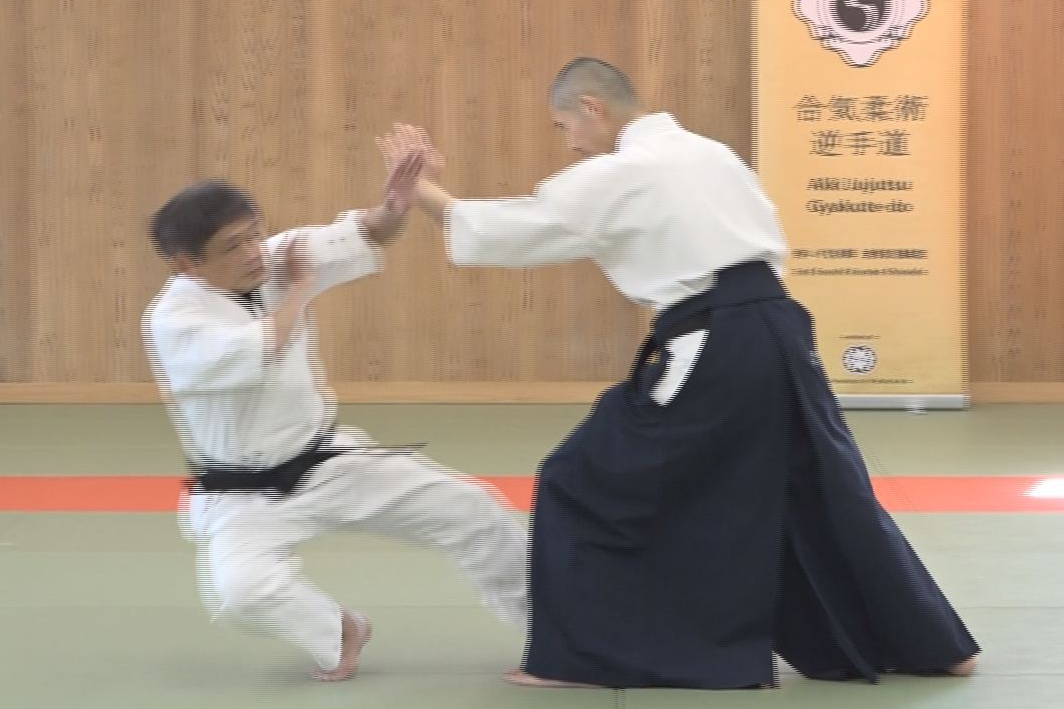
Lesson 1 - The Explanation of Waving Method
-
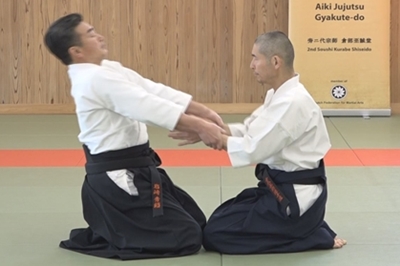
Introduction with video
and Knowledge of AIKI


